If you like Singaporean and Indonesian food, then you’re going to enjoy Malaysian food as well. All three cuisines share many similarities thanks to their shared histories, proximity, and similar ethnic makeup.
Meals consisting of rice topped with a small army of viands are just as common in Malaysia as they are in Singapore and Indonesia. Nasi lemak, satay, and laksa are national dishes while sambal is a staple condiment enjoyed with many Malaysian meals.
Like its neighbors, Malaysian food is known for its diversity and bold flavors so if you enjoy a lot of pep in your food, then you’re going to love Malaysian cuisine.
MALAYSIAN FOOD QUICK LINKS
If you’re planning a trip to Malaysia and want to learn more about the cuisine, then you may be interested in joining a food tour or taking a cooking class.
TOURS & OTHER SERVICES
- Food Tours: Food and Market Tours in Malaysia
- Cooking Classes: Cooking Classes in Malaysia
- eSIM: Malaysia eSIM
Save This on Pinterest!
No time to read this guide on the best food in Malaysia? Click on the save button and pin it for later!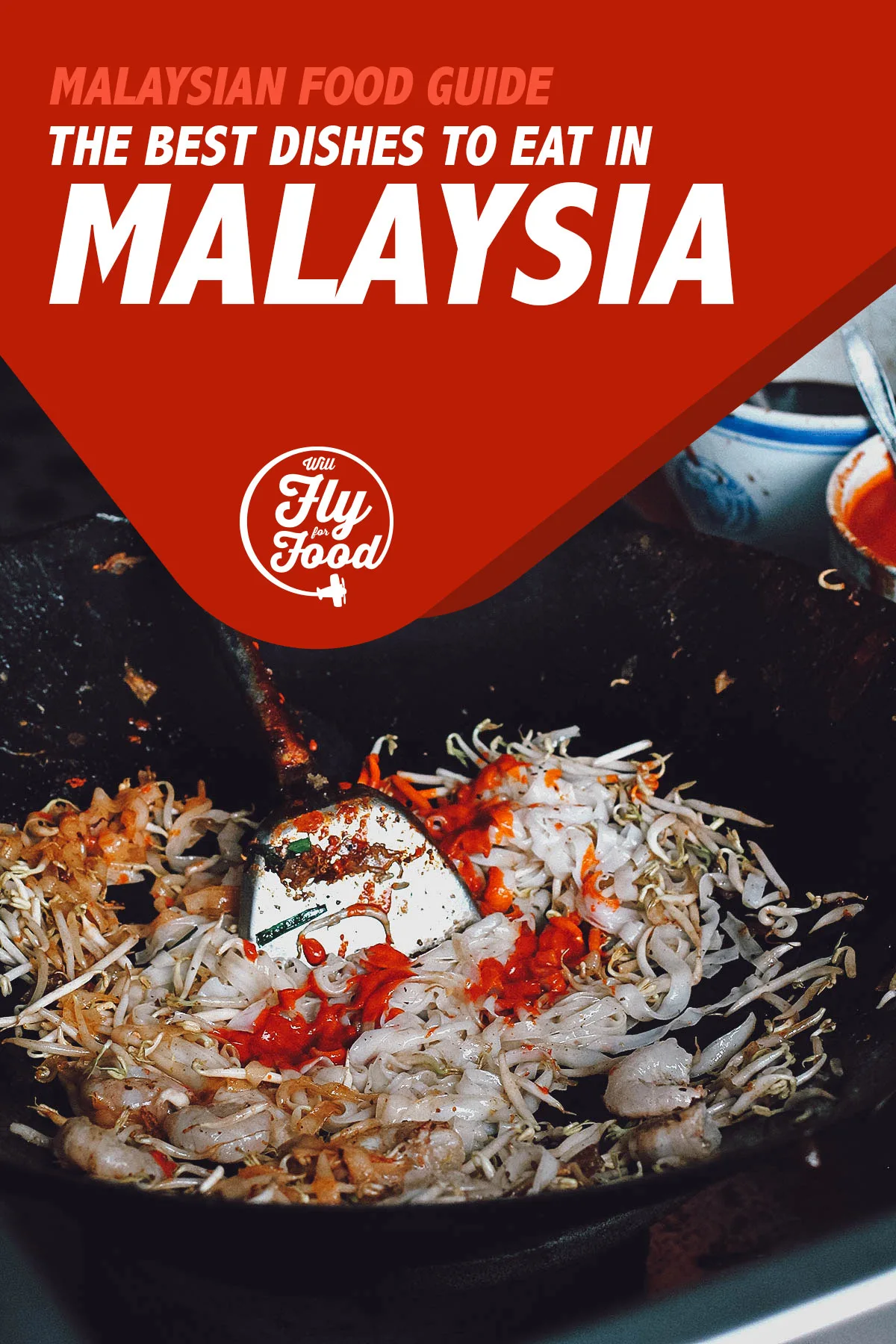
WHAT IS TRADITIONAL MALAYSIAN CUISINE?
Like Singapore, Malaysia’s population can be divided into three major ethnic groups – Malay, Chinese, and Indian. Because of its cultural diversity and historical migrations, Malaysian cuisine has evolved to become a mix of several different styles of cooking, primarily Malay, Chinese, Indian, Indonesian, and Bornean.
Food preparation is a communal affair in Malaysia and meals are often enjoyed without the use of utensils. I experienced this once on a food tour in Kuala Lumpur. My guide wanted me to have an authentic Malaysian food experience so he insisted I eat a plate of nasi kerabu with my hands. It was fun, though not as easy as it looks.
Speaking of nasi, rice is the most important staple food in Malaysia, followed by noodles and to a lesser degree, bread. Different types of seafood are common while chicken, beef, and mutton are the preferred meats.
Belacan (shrimp paste), coconut, and soy sauce are essential to Malaysian cooking while some of the most frequently used herbs and spices include chili, lemongrass, pandan (screwpine leaves), galangal, turmeric, and torch ginger.
THE BEST MALAYSIAN DISHES
A list of 35 Malaysian dishes can be difficult to digest so I’ve organized it by category to make it easier to go through. Click on a link to jump to any section.
STARTERS / SNACKS
1. Roti Canai
Roti canai refers to a flatbread dish popular in several Southeast Asian countries, including Malaysia where it’s considered a national dish. It’s originally a dish of Indian origin and is one of the most well-known examples of Malaysian-Indian food.
It’s made by repeatedly kneading, flattening, oiling, and folding dough before proofing it, to create layers. It’s then flattened and tossed until paper thin before being folded into a parcel and cooked on a griddle.
Roti canai is a popular breakfast dish or snack that’s traditionally served plain with a curry dip – usually dal (lentil) – but it can be filled with savory and sweet ingredients as well like egg, onion, cheese, sliced bananas, or kaya spread. Personally, it’s something we always order as a starter at Malaysian restaurants.
Roti canai is equally popular in Singapore where it’s known as roti prata. In Indonesia, it’s referred to as roti cane, roti konde, or roti maryam.
RECIPE: Roti canai
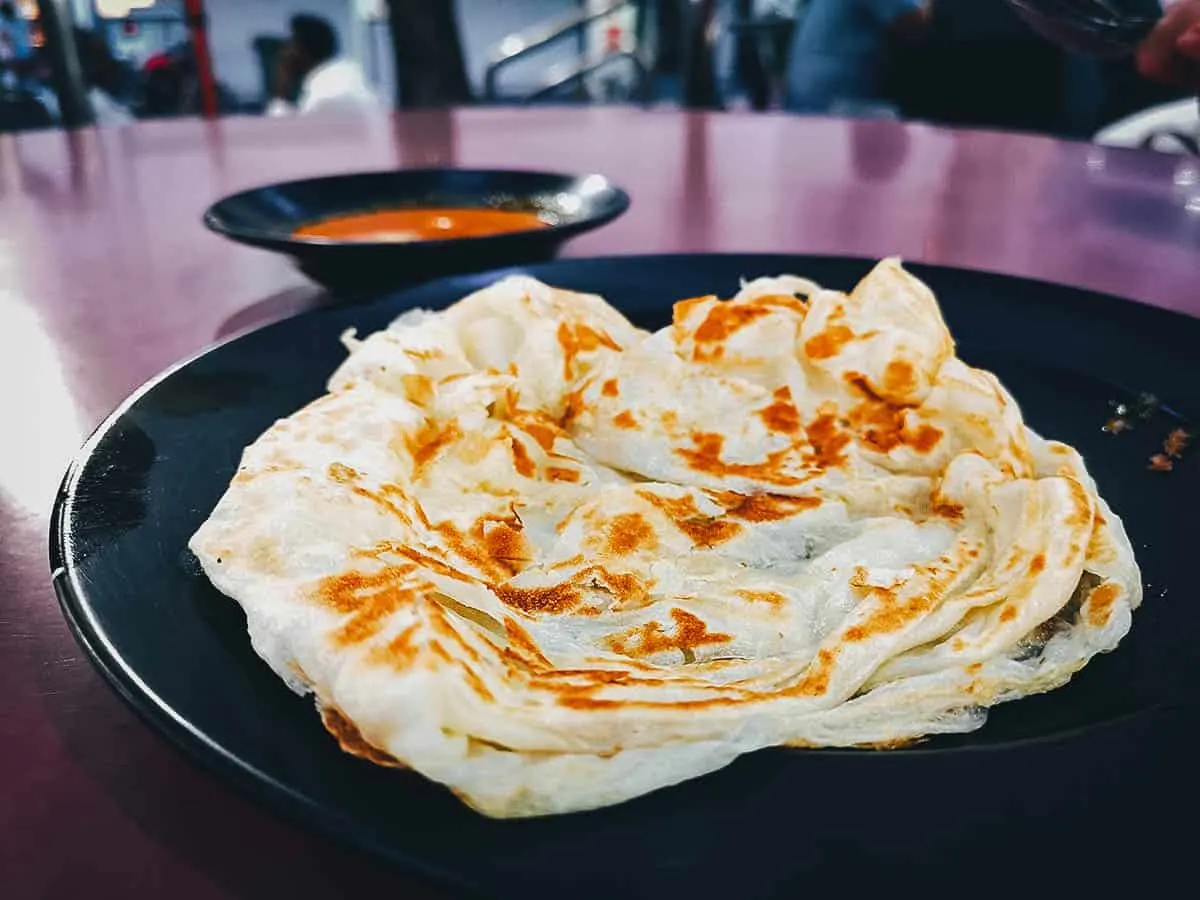
2. Lor Bak
Lor bak (or ngo hiang or heh gerng) refers to a Hokkien and Teochew dish that’s popular in Eastern China and in a few Southeast Asian countries like Malaysia, Indonesia, and Singapore.
It’s made with different types of meat, seafood, tofu, or vegetables that are seasoned with five-spice powder and rolled in a thin beancurd skin. They’re then deep-fried and served with chili sauce and loh, which is a sweet sauce thickened with corn starch and beaten eggs.
RECIPE: Lor bak
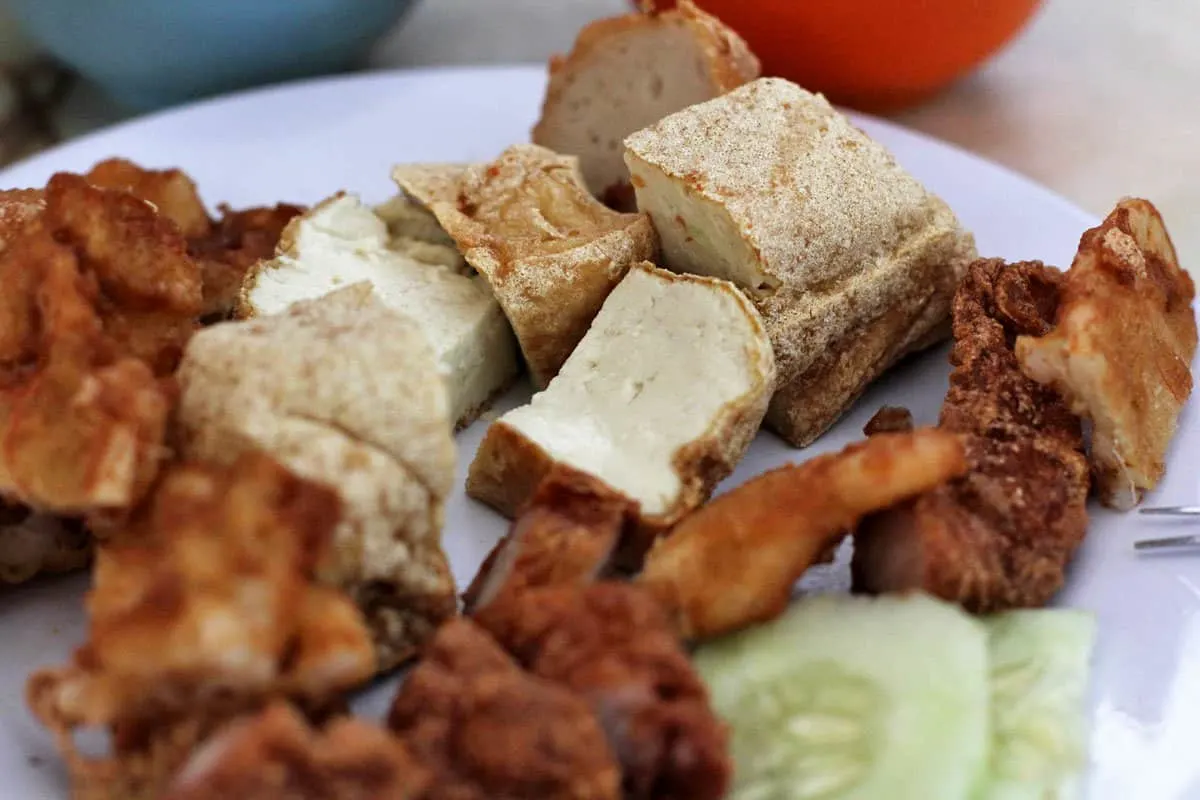
3. Popiah
Popiah refers to a Fujianese / Teochew-style fresh spring roll. Originally from Fujian province in China, it’s become a popular dish in Taiwan and in several Southeast Asian countries like Malaysia, Singapore, Thailand, and Vietnam.
Popiah is made with a thin, paper-like crepe or pancake smeared with a sweet bean sauce, hoisin sauce, or a shrimp paste sauce. It’s typically filled with finely grated turnip, jicama, bean sprouts, and lettuce leaves, though it’s often made with other ingredients as well like grated carrot, fried tofu, chopped peanuts, and shredded omelette.
RECIPE: Popiah
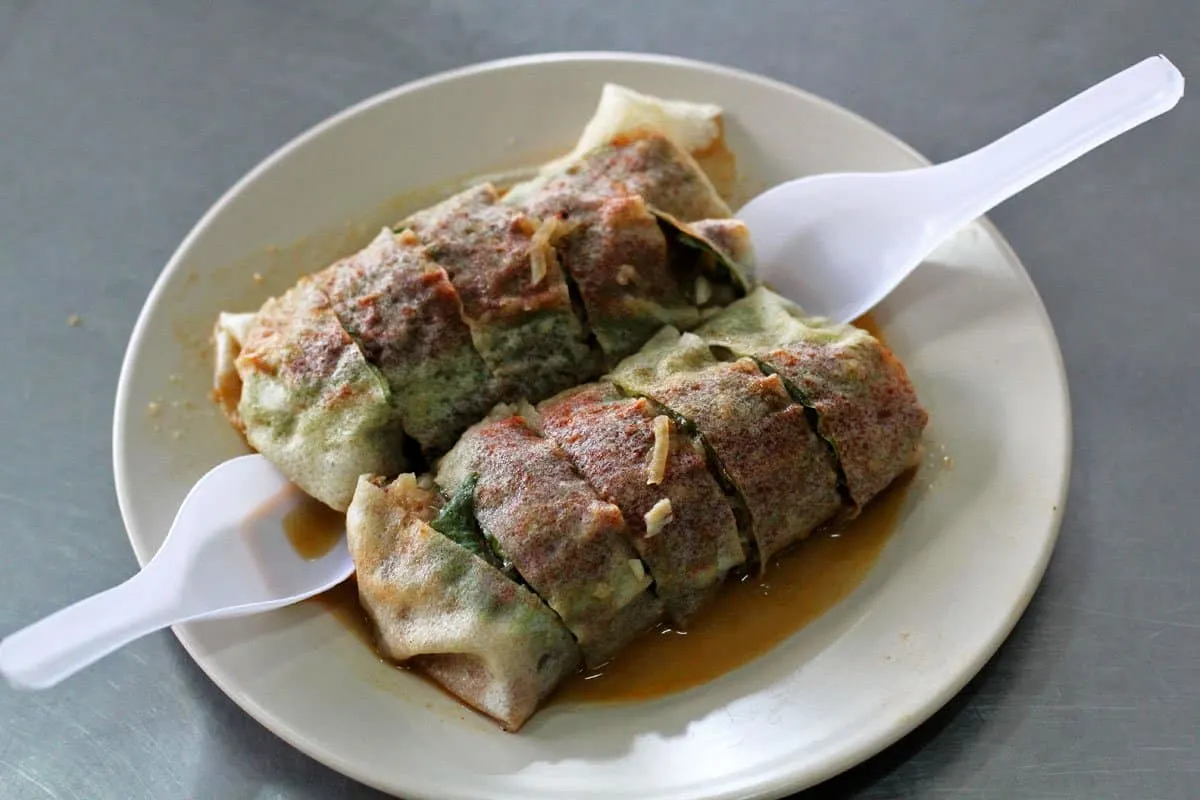
4. Char Koay Kak
If you’re familiar with Singaporean food, then you may recognize this dish. Originally a Teochew dish, it’s basically the Malaysian version of chai tow kueh or “fried carrot cake”.
Char koay kak refers to a dish made with radish cake (steamed rice flour, water, and shredded white daikon) stir-fried with eggs, preserved radish, bean sprouts, and seasonings. It’s a popular comfort food that’s widely enjoyed in Malaysia, from simple hawker stalls to more expensive Chinese restaurants.
Interestingly, in spite of its English nickname, this dish isn’t made with any carrots and bears no resemblance to western carrot cake. It came to be known as “carrot cake” in Singapore because the Hokkien word for radish – chai tow – can refer to a carrot or radish.
RECIPE: Char koay kak
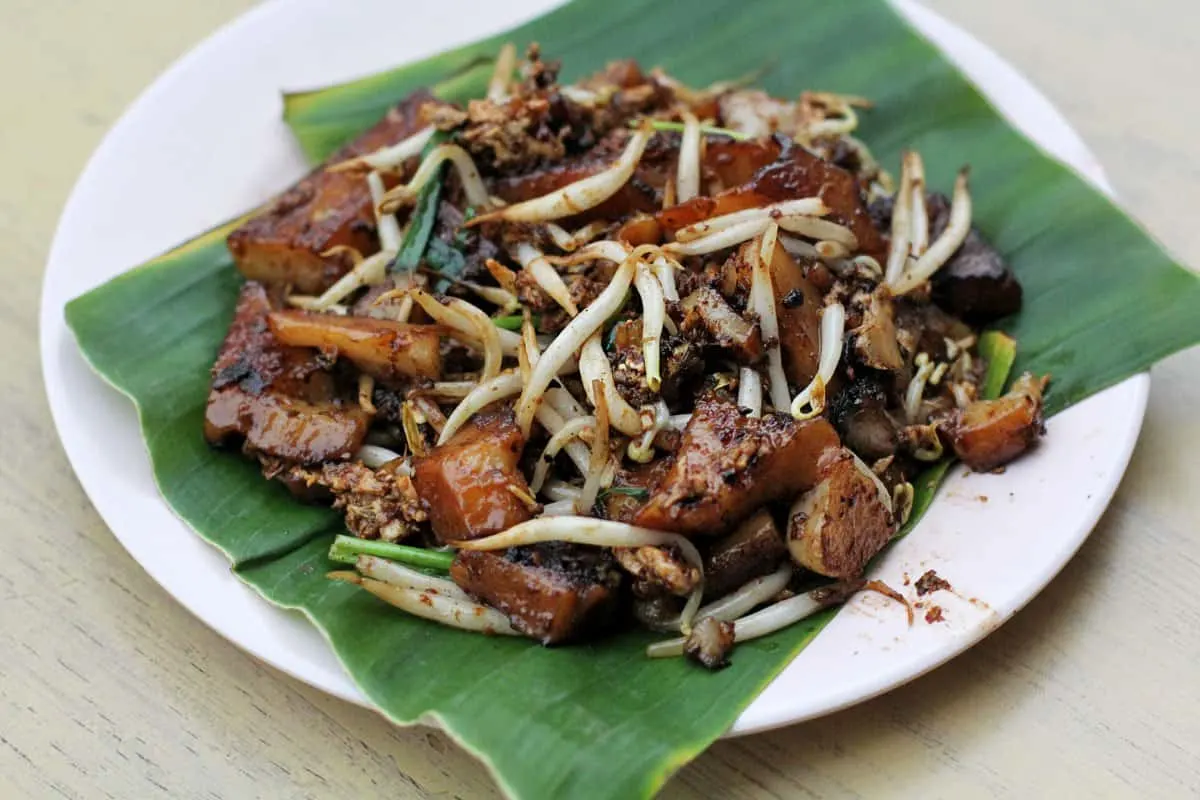
5. Rojak
Rojak refers to an Indonesian fruit and vegetable salad dish that’s also popular in Singapore and Malaysia. It’s typically sold at mamak stalls which are open-air establishments serving Indian Muslim cuisine.
Indonesian rujak is typically made with just fresh fruits and vegetables but Malaysian versions often contain other ingredients as well. It can contain things like fried tofu, boiled potatoes, hard-boiled eggs, and prawn fritters mixed together in a thick and spicy peanut sauce. This type of Malaysian rojak is known as rojak mamak.
Pictured below is another type of Malaysian rojak called rojak buah. It’s made with a variety of fresh fruits and vegetables like cucumber, pineapple, jicama, and green apples in a dressing made with shrimp paste, sugar, chilli, and lime juice.
RECIPE: Rojak
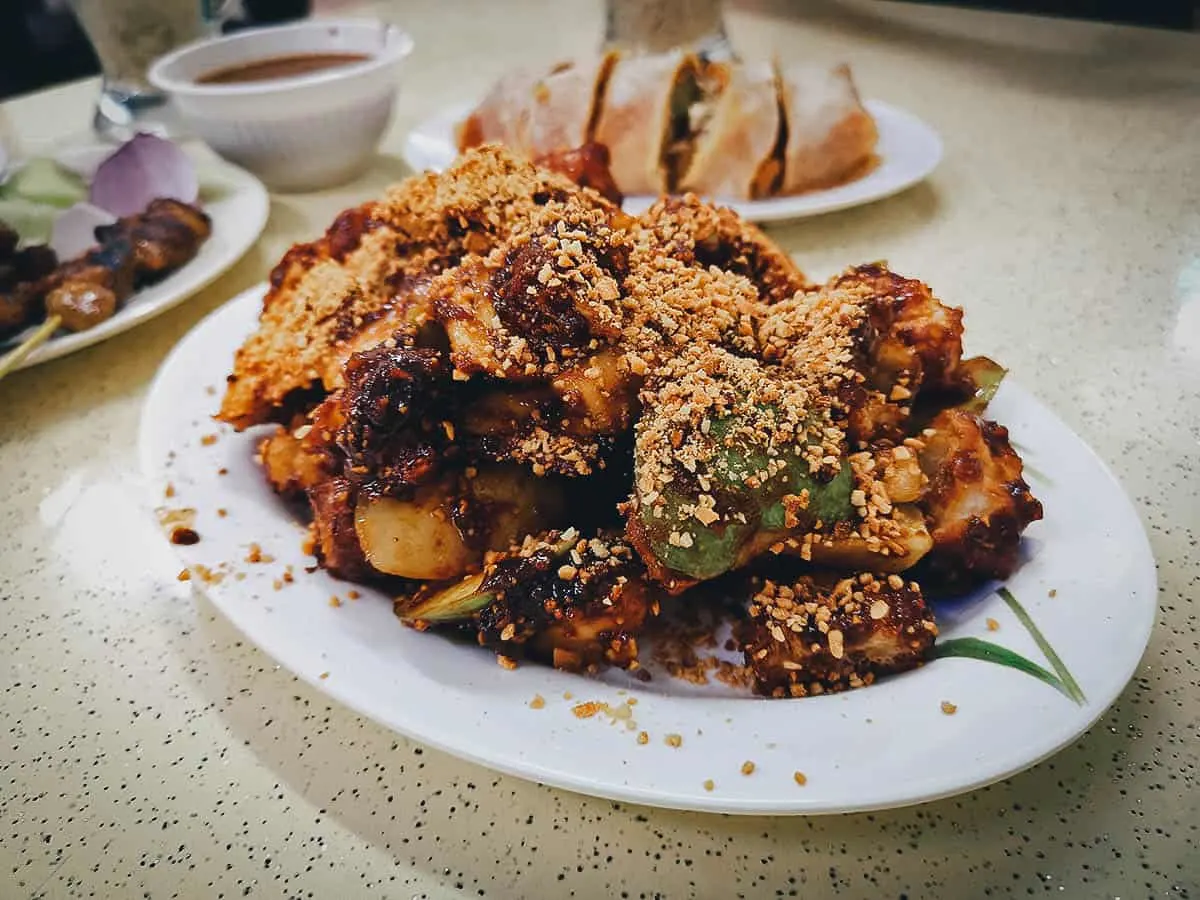
6. Ramly Burger
The Ramly Burger is an iconic Malaysian street food. In fact, when we were on a tour in Langkawi, our tour guide told us that the one Malaysian dish he missed the most from Kuala Lumpur was the Ramly Burger.
The term “Ramly Burger” is used to refer to any type of burger sold as street food in Malaysia. Preparations can vary from vendor to vendor but at their core, Ramly Burgers are made with beef or chicken patties produced by the Ramly Food Processing Company. The burger was invented by Ramly Mokni in 1979 and became an instant classic.
Thanks to our Langkawi tour guide, we became intrigued with the Ramly Burger so we decided to try it soon as we got back to Kuala Lumpur. As you can see below, the version we had was made with an omelette encasing the burger.
I don’t know how true it is but according to this recipe, a Ramly Burger can only be a Ramly Burger if its patty contains Maggi seasoning and a black pepper sauce made with milk, butter, oyster sauce, sweet soy sauce, and corn starch.
RECIPE: Ramly burger
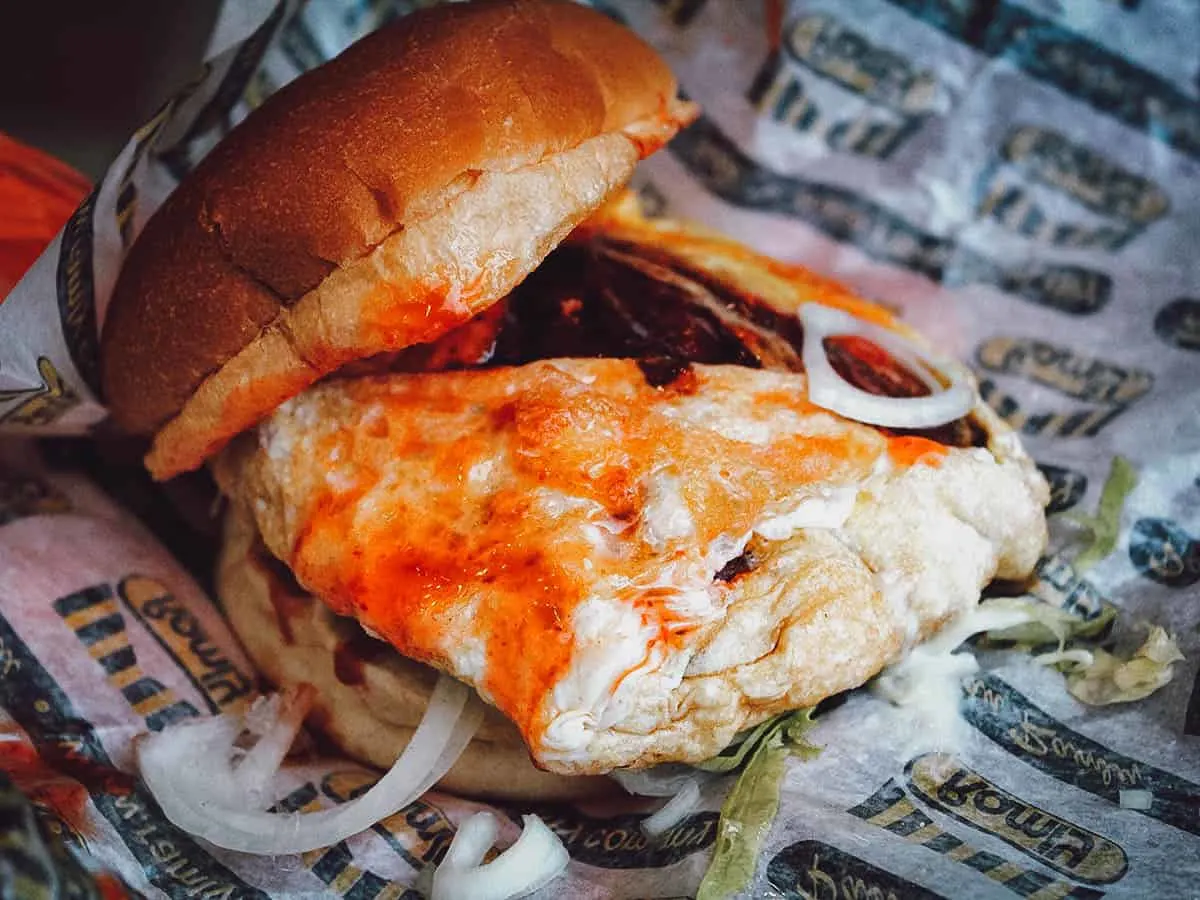
MEAT / POULTRY / SEAFOOD
7. Sate
Sate or satay is an Indonesian dish that’s become extremely popular in Malaysia and in other Southeast Asian countries. In fact, it’s become so integrated in Malaysian cuisine that it’s recognized as one of four national dishes in Malaysia. Nasi lemak, laksa, and roti canai are the others.
Sate refers to a family of seasoned meat that’s skewered and grilled over charcoal. It’s typically made with different types of meat like chicken, beef, pork, goat, and mutton but it can be made with other ingredients as well like seafood, fish balls, vegetables, and tofu. It’s usually served with a sate sauce made with roasted peanuts, palm sugar, tamarind, and chili.
Sate is ubiquitous throughout Malaysia and is equally popular at street food stalls as it is at proper sit-down restaurants. In Penang, you can try a specific type of sate called lok-lok which is basically a fusion of Chinese hot pot and sate.
RECIPE: Chicken satay
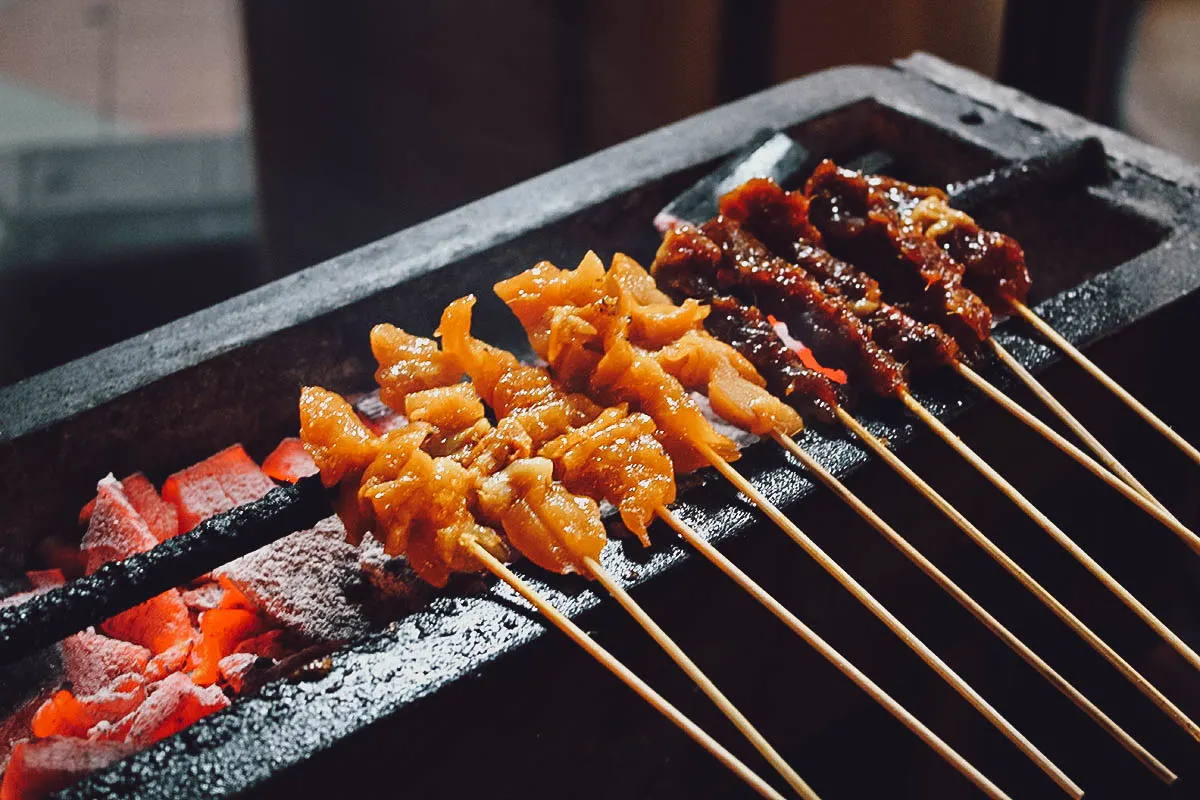
8. Lok-Lok
Lok-lok refers to a type of sate popular in Penang. It’s a fusion of sate and hot pot wherein different types of skewered meats, seafood, and vegetables are cooked in a communal pot of boiling water.
As you can see below, a variety of ingredients like raw meat, tofu, dumplings, fish cake, offal, and century eggs are skewered on bamboo sticks and spread out around a central pot. Sticks are color-coded for price and diners are free to grab whatever they want and cook them inside the pot. When ready, the sate is enjoyed with sate sauce and sambal.
Lok-lok is a popular type of meal in Penang and can be enjoyed at restaurants and hawker centers, even from street food carts. It’s interesting to see people gathered around a mobile cart dipping sticks of sate into a boiling pot of water.
RECIPE: Lok-lok
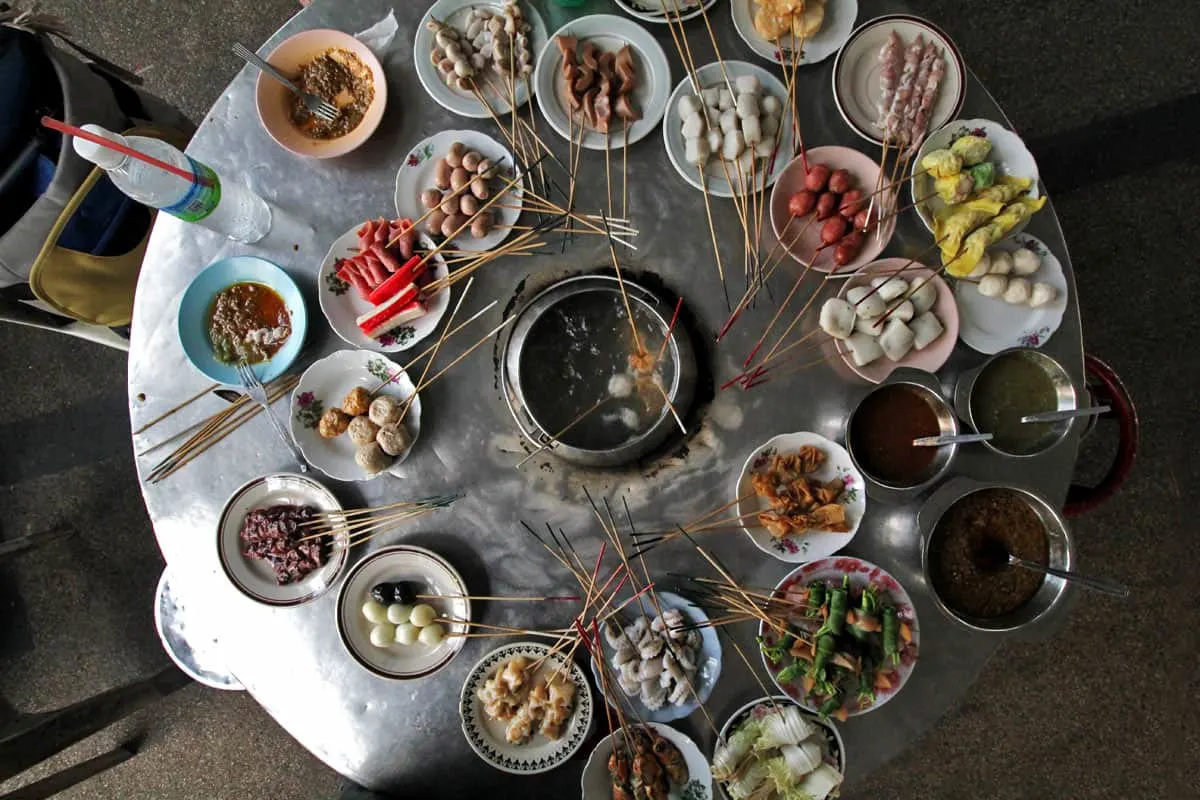
9. Bak Kut Teh
Bak kut teh refers to a Hokkien and Teochew pork rib dish that’s popular in Malaysia and Singapore. It consists of meaty pork ribs simmered for many hours in a complex broth made with a variety of herbs and spices like star anise, cinnamon, cloves, and fennel seeds.
Interestingly, the name bak kut teh translates to “meat bone tea” though no tea is actually used to make the dish. The “tea” refers to the strong oolong Chinese tea that’s usually served with the dish. It’s meant to dilute the large amount of pork fat that’s often consumed in bak kut teh.
In Malaysia, bak kut teh is often served with you char kway (fried dough) and a dip made with soy sauce, chili, and garlic. A dry type of bak kut teh is also available along with a less fatty version made with chicken called chik kut the.
RECIPE: Bak kut teh
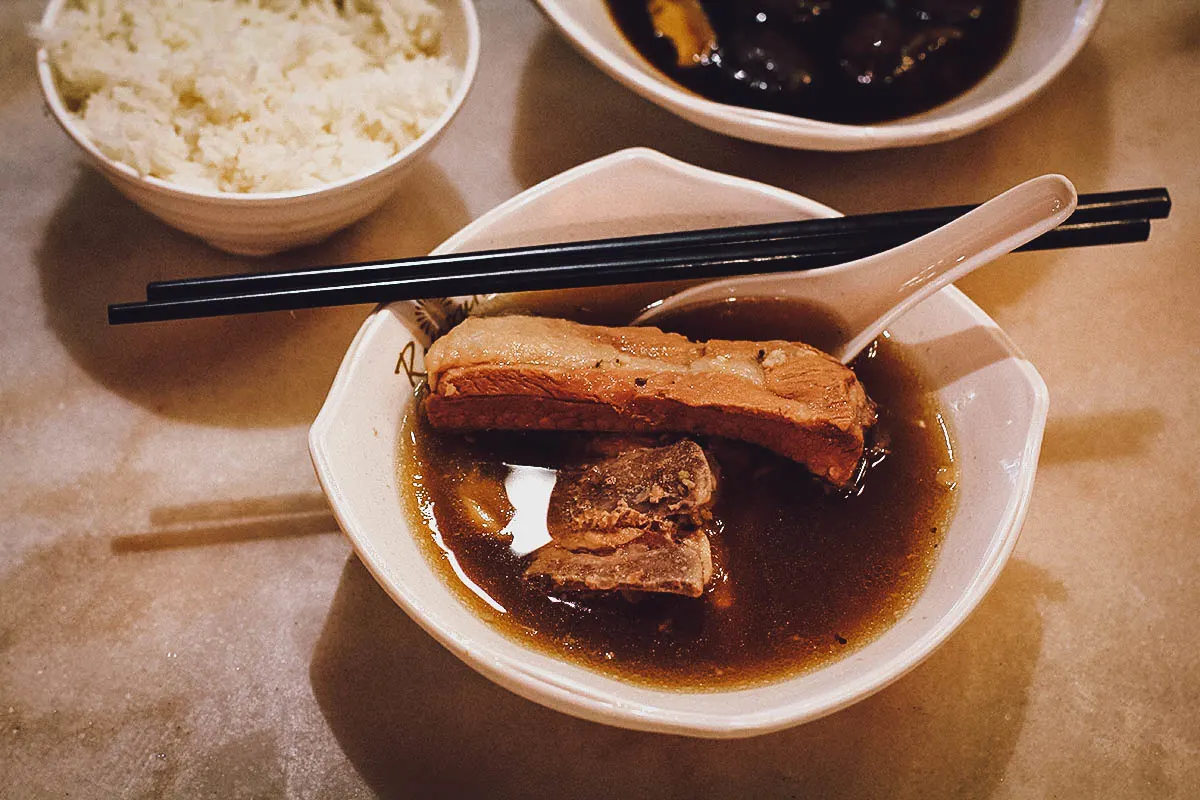
10. Rendang
Rendang is an Indonesian meat dish that’s become popular in other parts of Southeast Asia like Malaysia, Singapore, and Brunei. Believed to have been influenced by North Indian curry, it consists of meat stewed for many hours in coconut milk and spices.
Like Indonesian rendang, Malaysian rendang is traditionally made with beef that’s braised in a coconut milk and spice mixture. The beef is slow-cooked for several hours until the liquid evaporates and the meat becomes caramelized and fork tender.
Beef is the most common though rendang can be made with other types of meat and seafood as well like chicken, goat, water buffalo, sting ray, and crab. Pictured below is ayam rendang or chicken rendang served with a small portion of sambal sotong.
RECIPE: Beef rendang
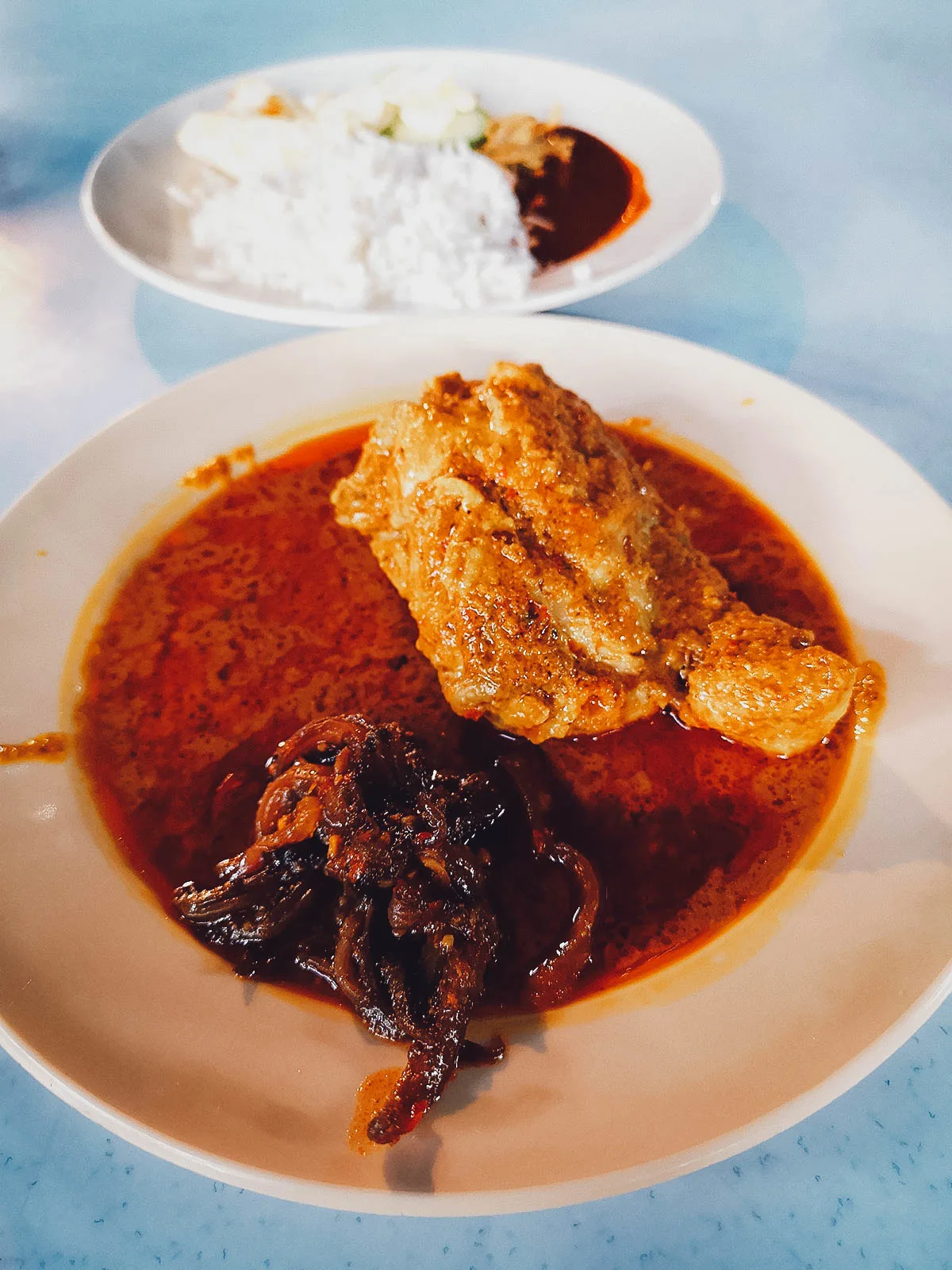
11. Kari Ayam
Kari ayam refers to an Indian-inspired chicken curry dish popular in Malaysia and Indonesia. It consists of chicken pieces cooked with lemongrass, kaffir lime leaves, coconut milk, and a spice paste called rempah.
Rempah is similar to Indian masala and is made with a heady mix of spices like chili, coriander seeds, cumin, fennel, cinnamon, turmeric, and galangal, among others.
RECIPE: Kari ayam
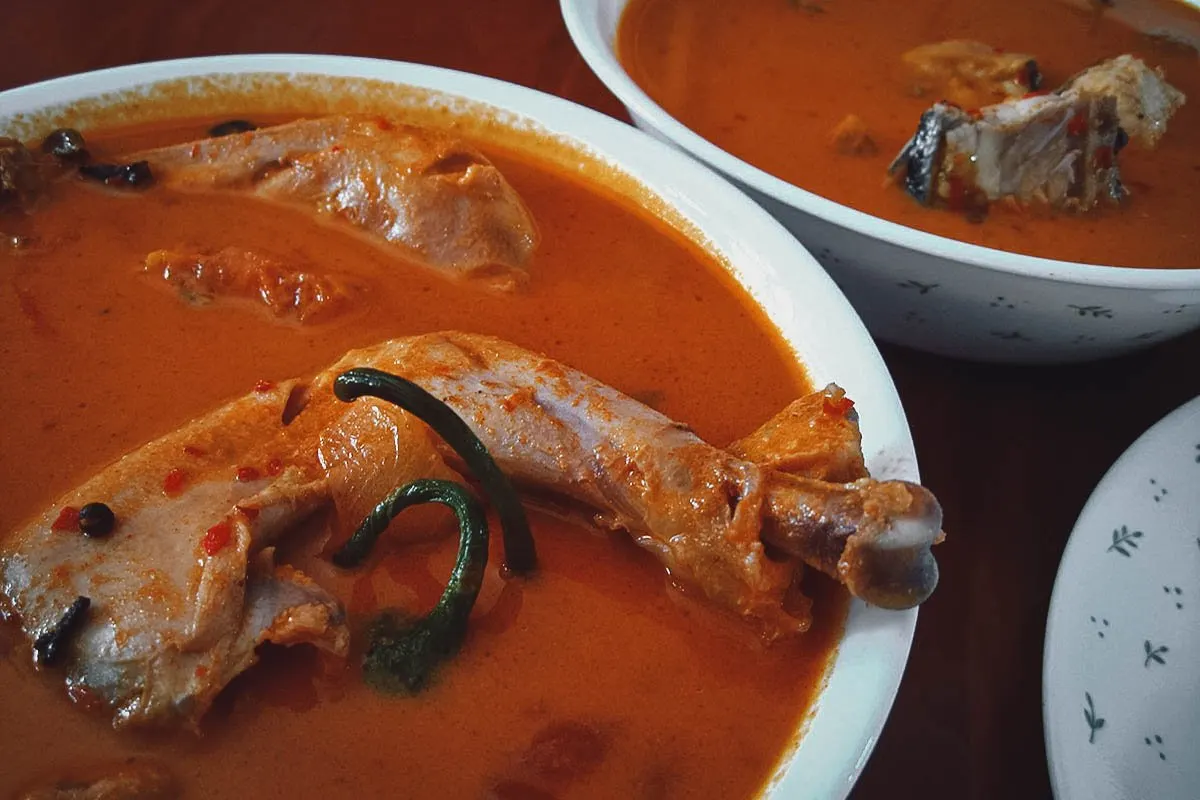
“kari ikan & kari ayam” by surtr, used under CC BY-SA 2.0 / Processed in Photoshop and Lightroom
12. Oh Chien
Oh chien refers to a Teochew and Hokkien dish that’s become popular in Taiwan and in many parts of Southeast Asia like Malaysia, Thailand, and Singapore. Depending on where it’s from, it goes by different names like o-a-tsian, orh jian, and orh luak.
Oh chien is an oyster omelette made with fresh raw oysters, starch, and eggs. It’s typically made with sweet potato starch mixed into the egg batter to give it a thicker, gooier texture. It’s fried till crispy and served with a side of chili sauce mixed with lime juice.
RECIPE: Oh chien
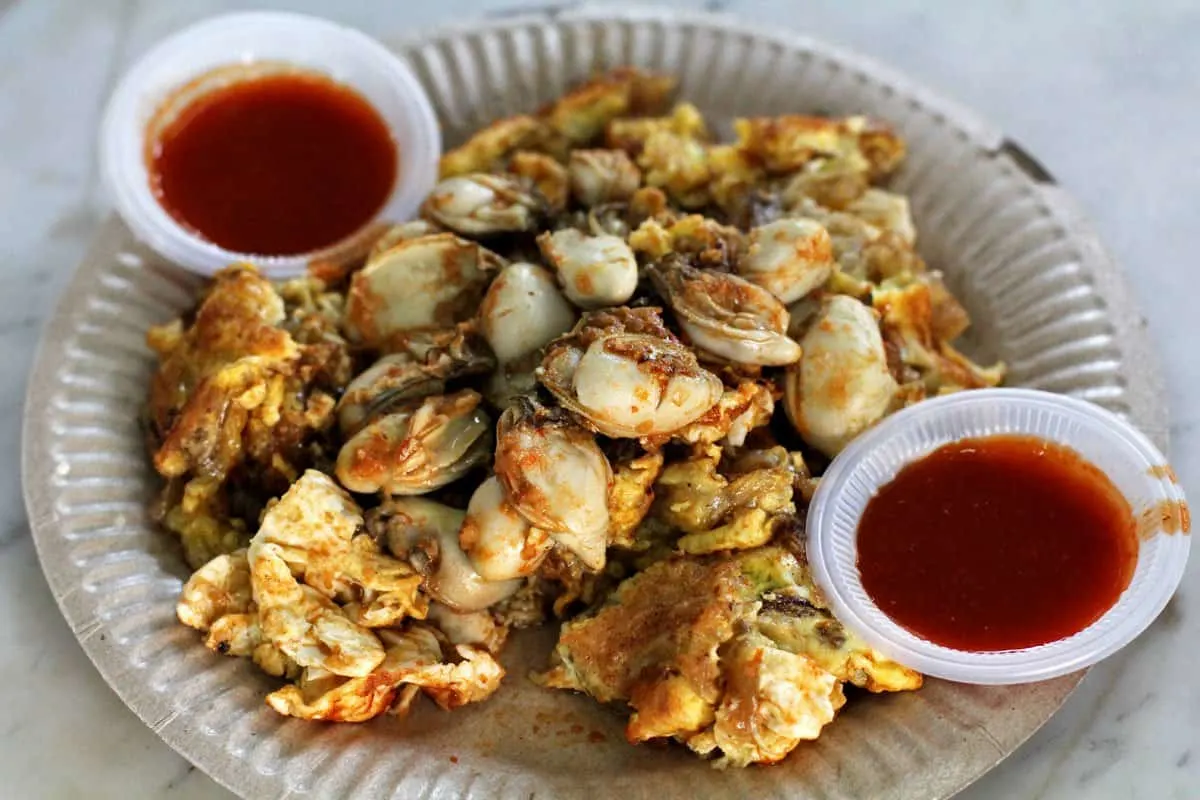
13. Ikan Bakar
Ikan bakar means “grilled fish”. It refers to Malasyian and Indonesian fish dishes that are seasoned with a spice marinade and wrapped in banana leaves before being quickly grilled over a hot charcoal flame.
Ikan bakar can be made with pretty much any type of fish, though some of the most popular include freshwater gourami, carp, mackerel, red snapper, rabbitfish, and stingray. Ikan literally means “fish” but the term ikan bakar can be used to described other types of grilled seafood as well like grilled squid and grilled shrimp.
Ikan bakar is equally popular in Malaysia and Indonesia though they do differ in spices used. Malaysian ikan bakar tends to be spicier and more yellowish in color because of its heavier use of chili and turmeric. It’s also lighter due to the absence of kecap manis.
RECIPE: Ikan bakar
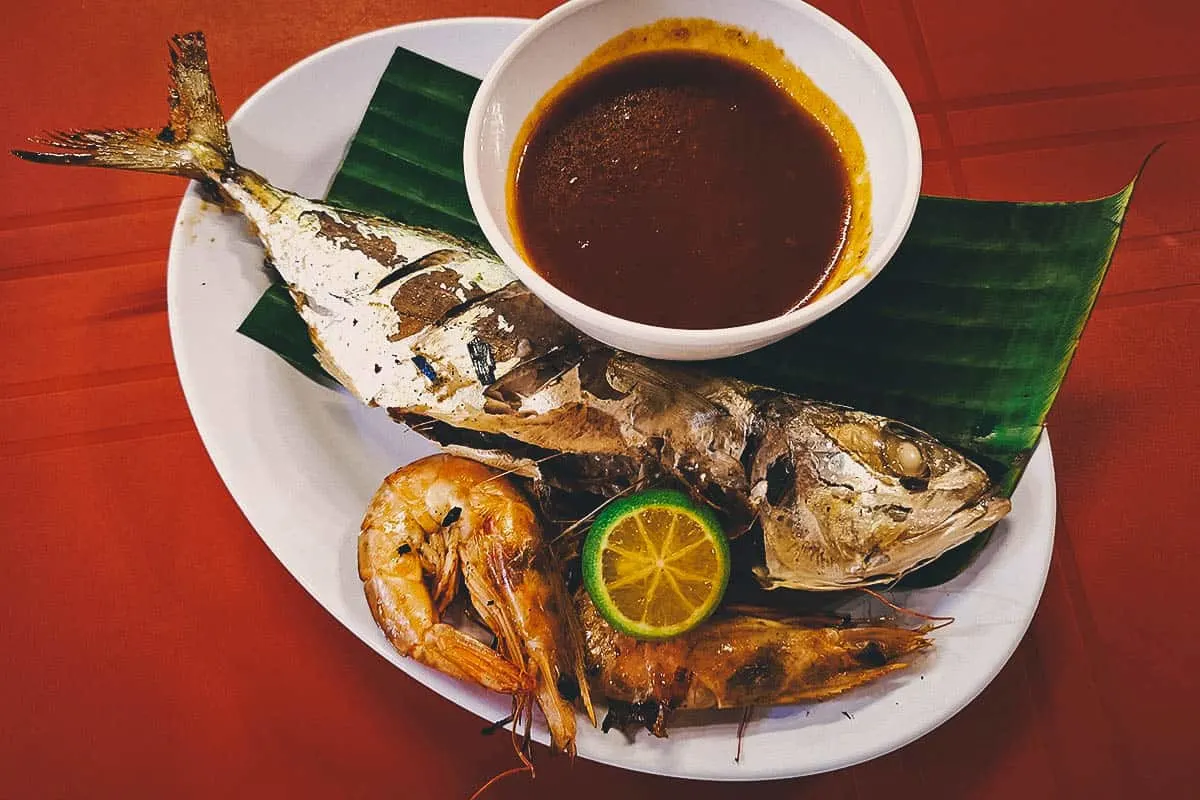
14. Kari Kepala Ikan
Kari kepala ikan refers to a curry dish made with a whole fish head. It’s a dish with Chinese and Indian origins that’s become popular in Malaysia, Singapore, and Indonesia.
Kari kepala ikan is made with the whole head of a red snapper stewed in a Kerala-style curry. It contains a mix of vegetables like okra and eggplant and is often seasoned with over a dozen spices.
RECIPE: Fish head curry
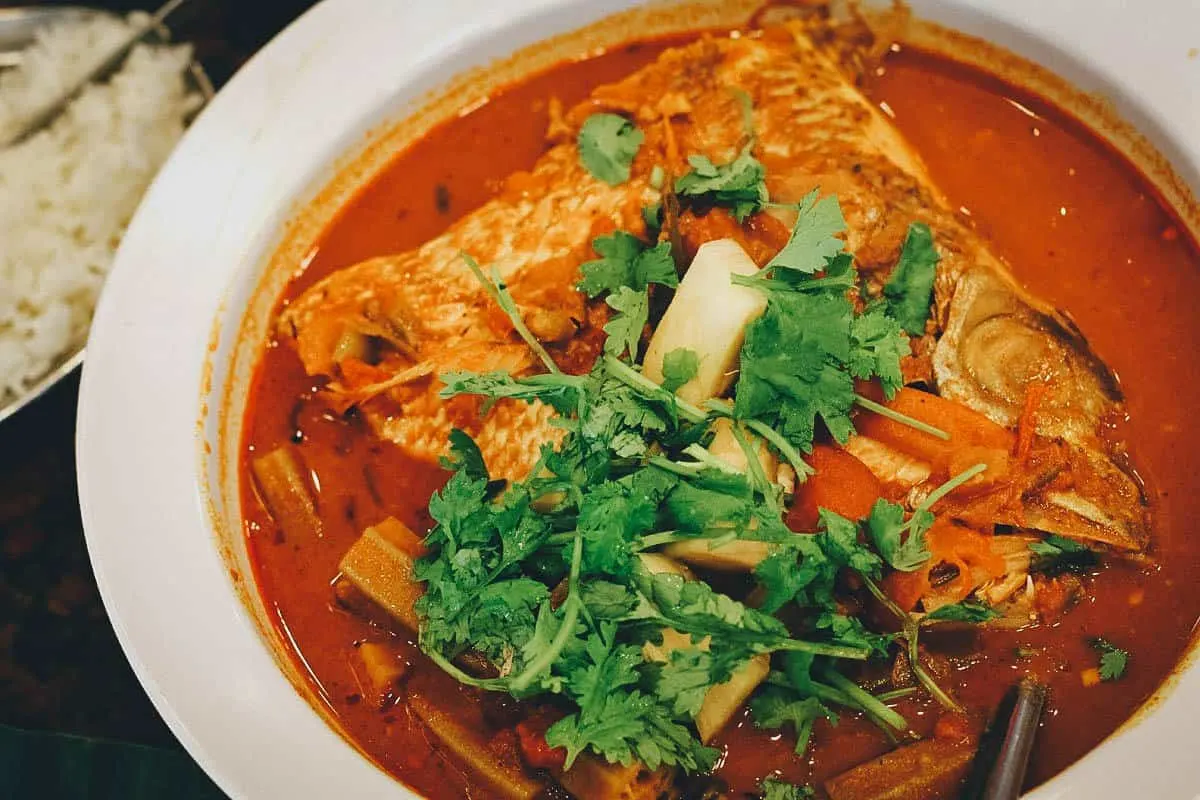
15. Sambal Sotong
Sambal is typically enjoyed as a condiment though it can be used as an ingredient as well. Sambal sotong or chili squid is an example of a dish that incorporates sambal as an ingredient. It consists of squid cooked in a sambal-based sauce.
RECIPE: Sambal sotong
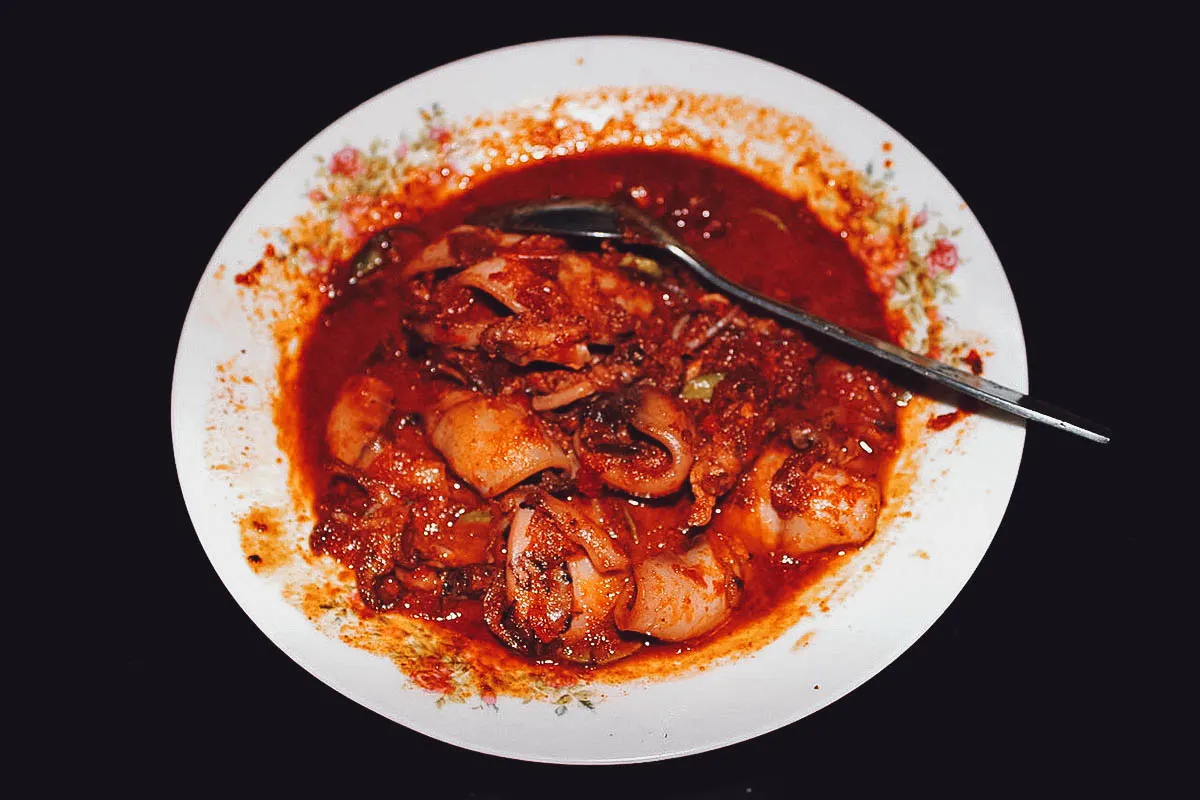
SpartacksCompatriot, CC BY-SA 3.0, via Wikimedia Commons / Processed in Photoshop and Lightroom
NOODLES
16. Curry Laksa / Curry Mee
Curry laksa (or simply laksa) refers to a Peranakan noodle soup dish popular in Malaysia, Singapore, and Indonesia. It consists of thick wheat noodles or rice vermicelli cooked in a rich and spicy curry coconut milk soup.
Curry laksa is made with a spice paste consisting of a variety of ingredients like garlic, shallots, lemongrass, and belacan. It’s usually topped with deep-fried tofu, a hard-boiled egg, bean sprouts, cockles, shrimp, and cuttlefish. It’s then served with a side of sambal and sometimes garnished with coriander.
Interestingly, the Penang version of curry laksa is referred to as curry mee. Curry laksa and curry mee are one and the same dish, but the term “curry mee” is used in Penang to differentiate it from asam laksa. Penang curry mee typically includes cubes of congealed pork blood.
RECIPE: Curry laksa
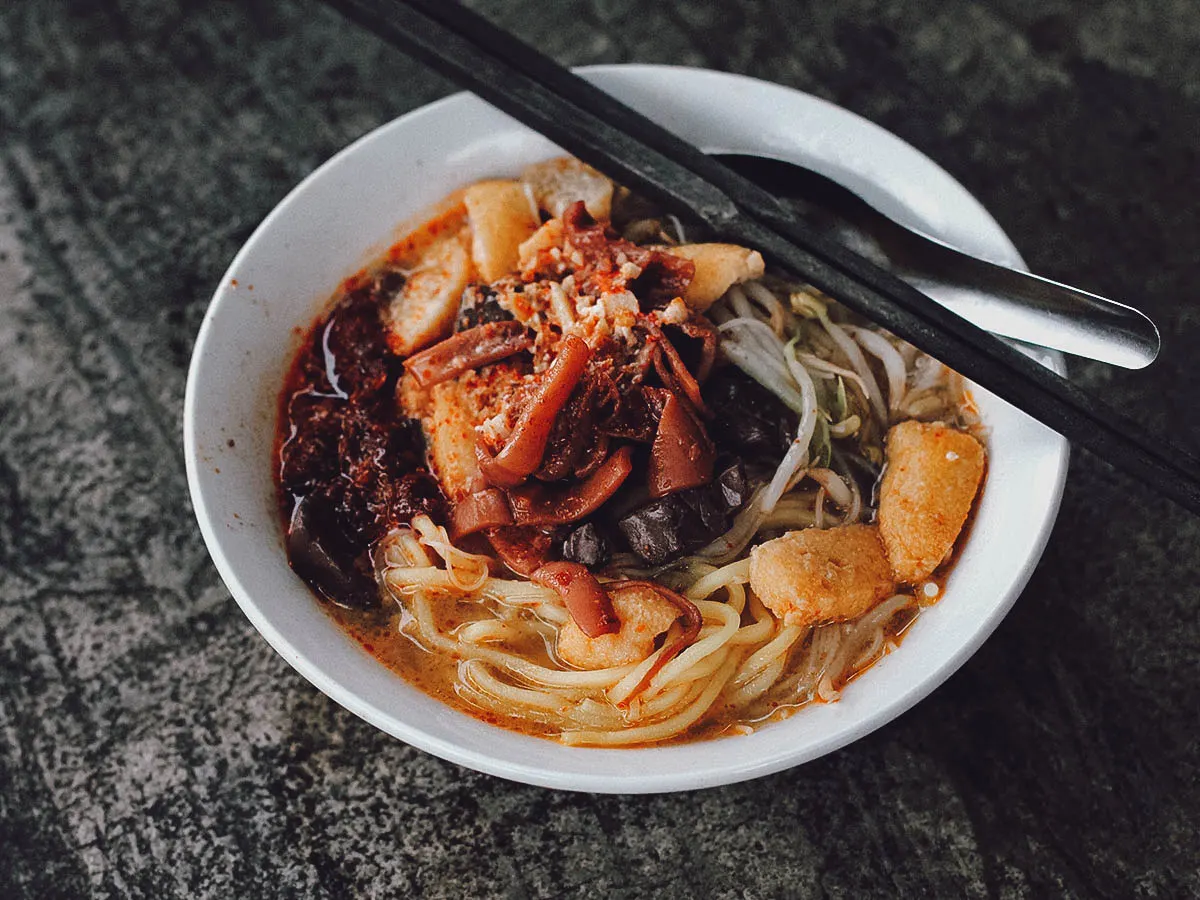
17. Asam Laksa
Asam laksa is the reason why curry laksa is referred to as curry mee in Penang. It refers to a type of laksa made with a souring agent (asam) like tamaring or gelugur instead of coconut milk.
Unlike curry laksa which is rich and creamy, asam laksa is tangy, sharp-tasting, and spicy. Aside from the souring agent, asam laksa is usually made with shredded mackerel and finely sliced vegetables like cucumber, onions, red chilli, pineapple, mint leaves, laksa leaves, and torch ginger. It’s usually served with thick or thin rice noodles and topped with a sweet shrimp paste called otak udang.
There are a few regional variations of asam laksa though the Penang version is one of the most well-known. In fact, it’s the only Malaysian dish that made it to CNN Travel’s list of the World’s 50 Best Foods.
Asam laksa is definitely a dish that you shouldn’t miss when you visit Penang. Check out our Penang food guide to learn where you should try it.
RECIPE: Asam laksa
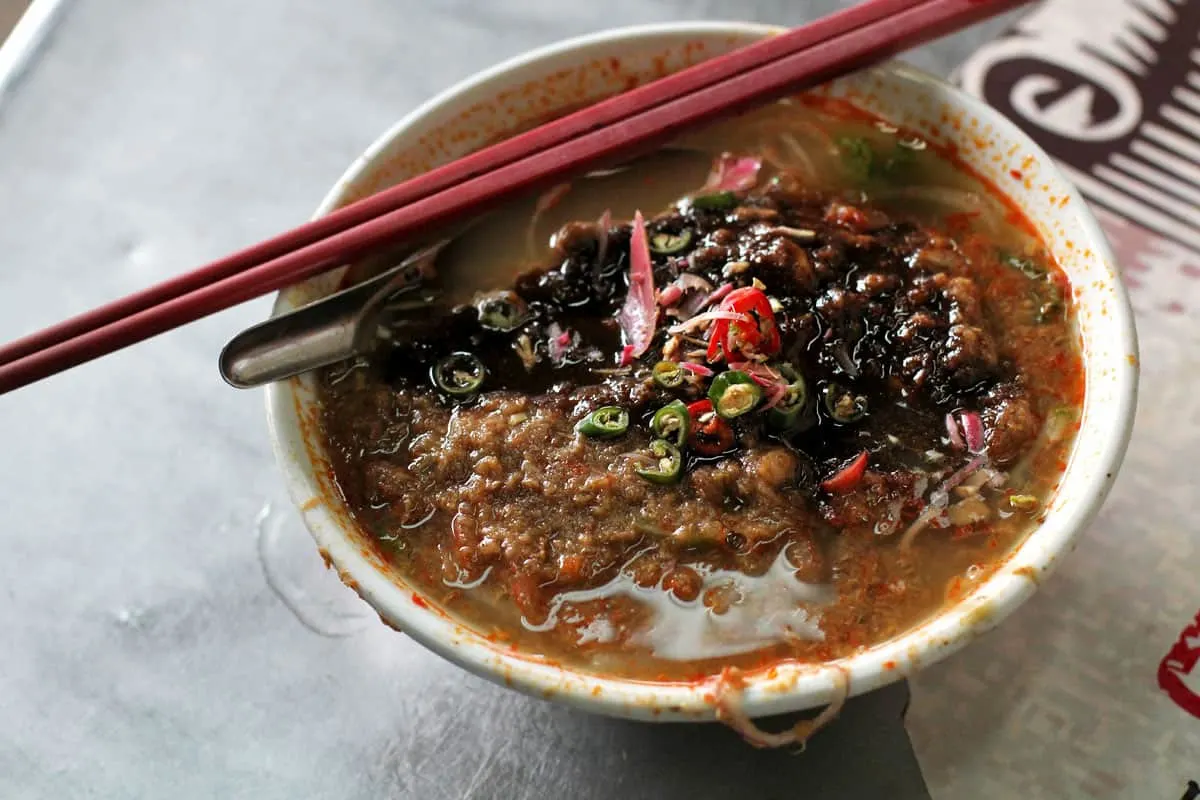
18. Koay Teow Th’ng
Koay teow th’ng refers to a Chinese noodle soup popular in Malaysia and Singapore. It’s a popular Penang hawker food made with flat rice noodles served in a clear broth containing a mix of ingredients like fish balls, chicken, duck, pork, vegetables, chopped scallions, and browned garlic bits.
Koay teow th’ng is relatively colorless and bland but looks can be deceiving. When done right, it’s an incredibly flavorful dish with silky soft noodles and perfectly springy fish balls. It was easily one of our favorite dishes to eat in Penang which is saying a lot considering the island’s reputation as a Malaysian street food paradise.
For even more flavor, koay teow th’ng is often served with a side of soy-vinegar with chopped red chilies.
RECIPE: Koay teow th’ng
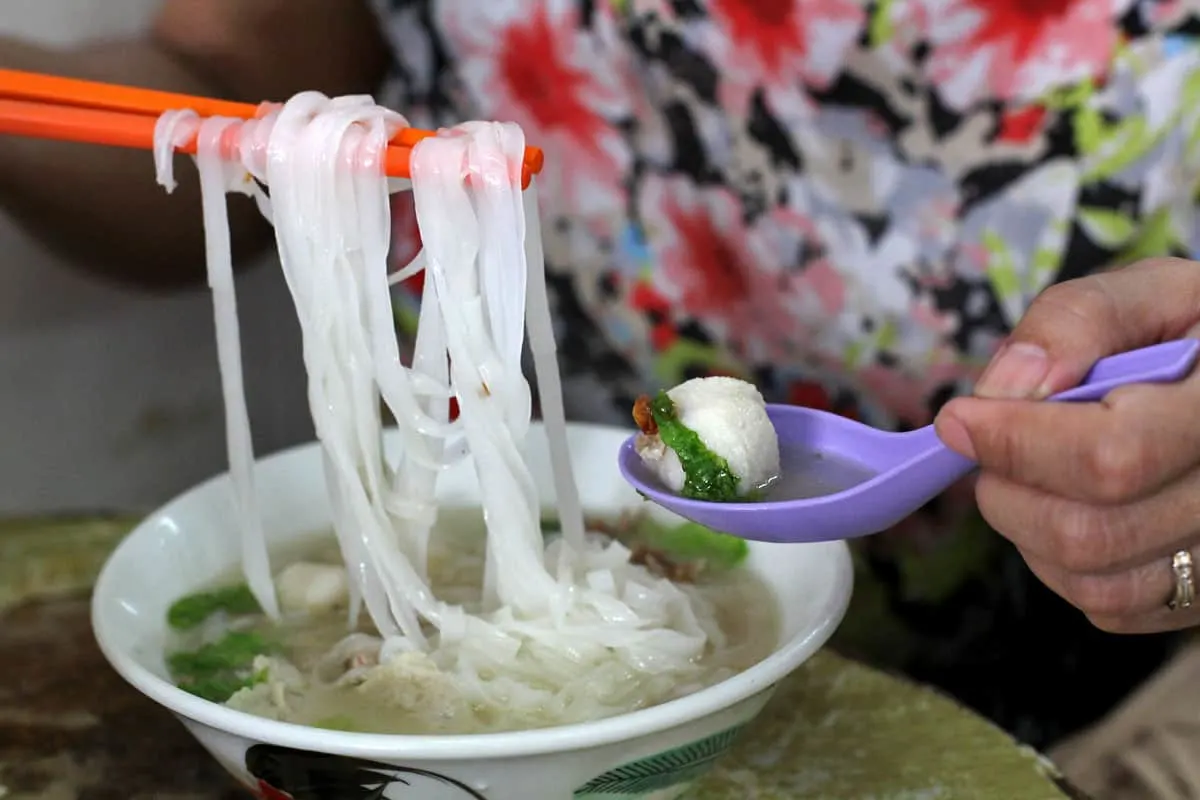
19. Kway Chap
Kway chap or kuay chap refers to a Teochew noodle soup made with flat, broad rice noodles (kway) served in a soup made with dark soy sauce. It’s popular in parts of Malaysia and in Singapore.
Kway chap is typically served with braised duck meat, beancurd, fish cake, salted vegetables, braised hard-boiled eggs, and different cuts of pork like offal, pork belly, intestines, and pig’s ears. Unlike koay teow th’ng which is deceptively flavorful, kway chap is every bit as tasty as it looks.
One of the most interesting components of this dish is the kway or broad rice noodles. Unlike conventional noodles which are long and stringy, kway chap noodles are short, flat, and chewier in texture. You can see a few pieces on the spoon below.
RECIPE: Kway chap
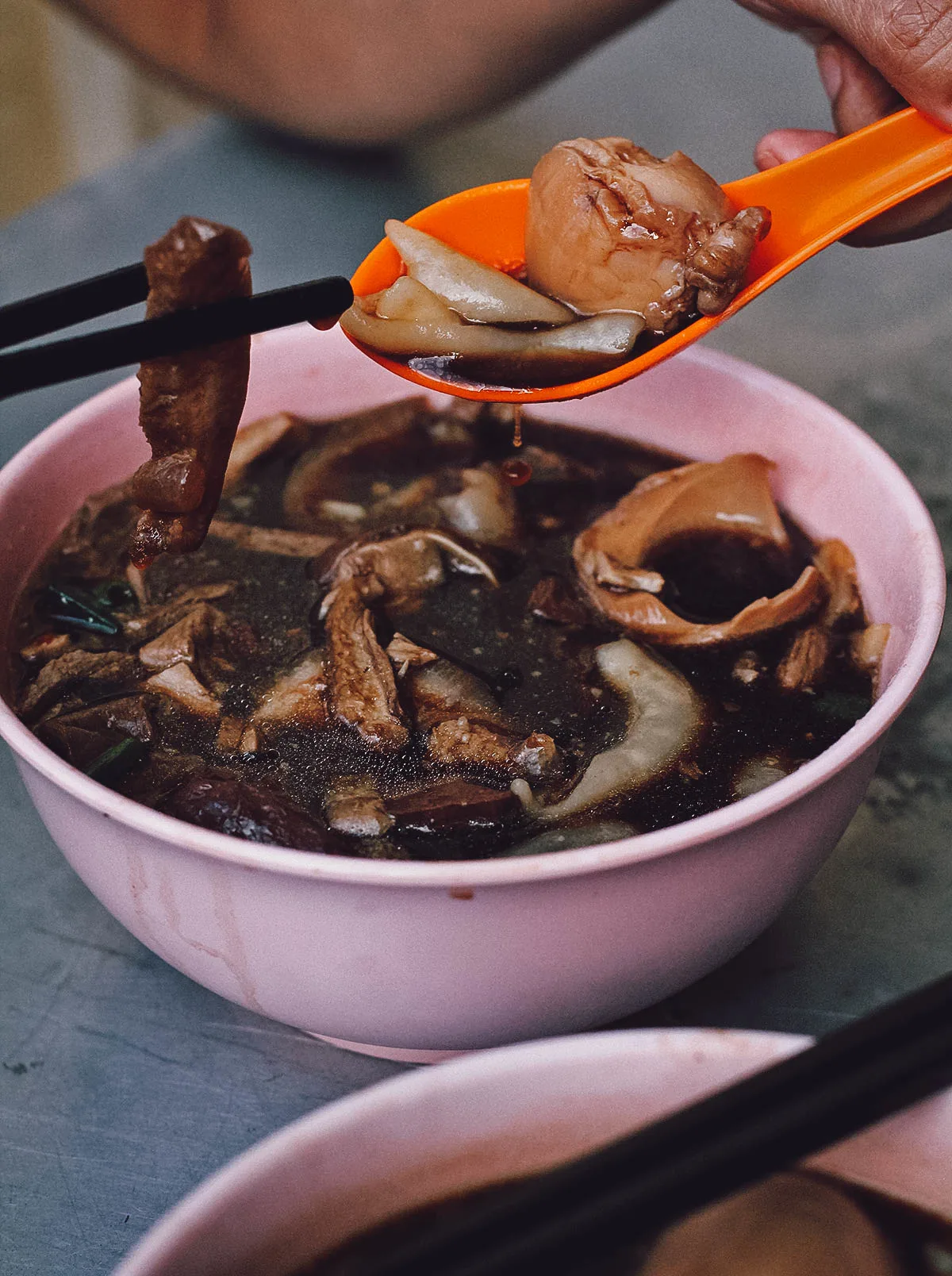
20. Char Kway Teow
Char kway teow refers to a Chinese stir-fried noodle dish popular in Malaysia, Singapore, Indonesia, and Brunei. Char means “stir-fried” while kway teow refers to the flat rice noodles used in the dish.
To prepare, kway teow noodles are stir-fried over very high heat in pork fat with a host of ingredients like light and dark soy sauce, chili, belacan, prawns, blood cockles, Chinese chives, fishcake, and bean sprouts. It’s often served on a plate lined with banana leaf to enhance the aroma of the noodles.
Char kway teow is an extremely popular dish in Malaysia and often the subject of intense debate. Everyone has an opinion on who makes the best and no one is ever wrong.
In Penang, we had this fantastic char kway teow made even more decadent with duck eggs. It was rich and delicious with that indescribable flavor of wok hei.
RECIPE: Char kway teow
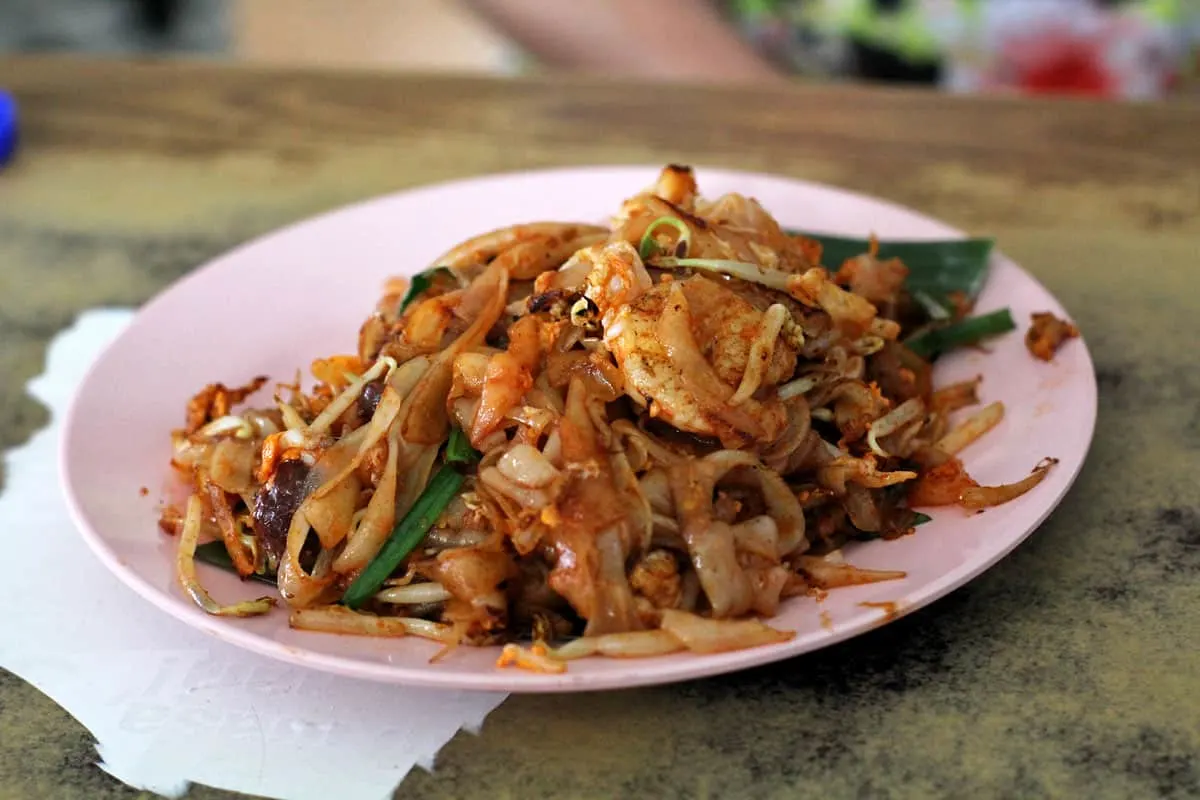
21. Maggi Goreng
Maggi goreng refers to a specific way of preparing instant noodles, specifically the Maggi brand of instant noodles which is popular in Malaysia.
Instead of just boiling the noodles and then flavoring the broth with the sachet of seasonings as instructed, the noodles are stir-fried with different ingredients like vegetables, eggs, tofu, sambal, soy sauce, and meat. It’s basically just a quick and easy stir-fry noodle dish made using instant noodles.
Maggi goreng varies from vendor to vendor and is commonly sold at mamak stalls in Malaysia and Singapore.
RECIPE: Maggi goreng
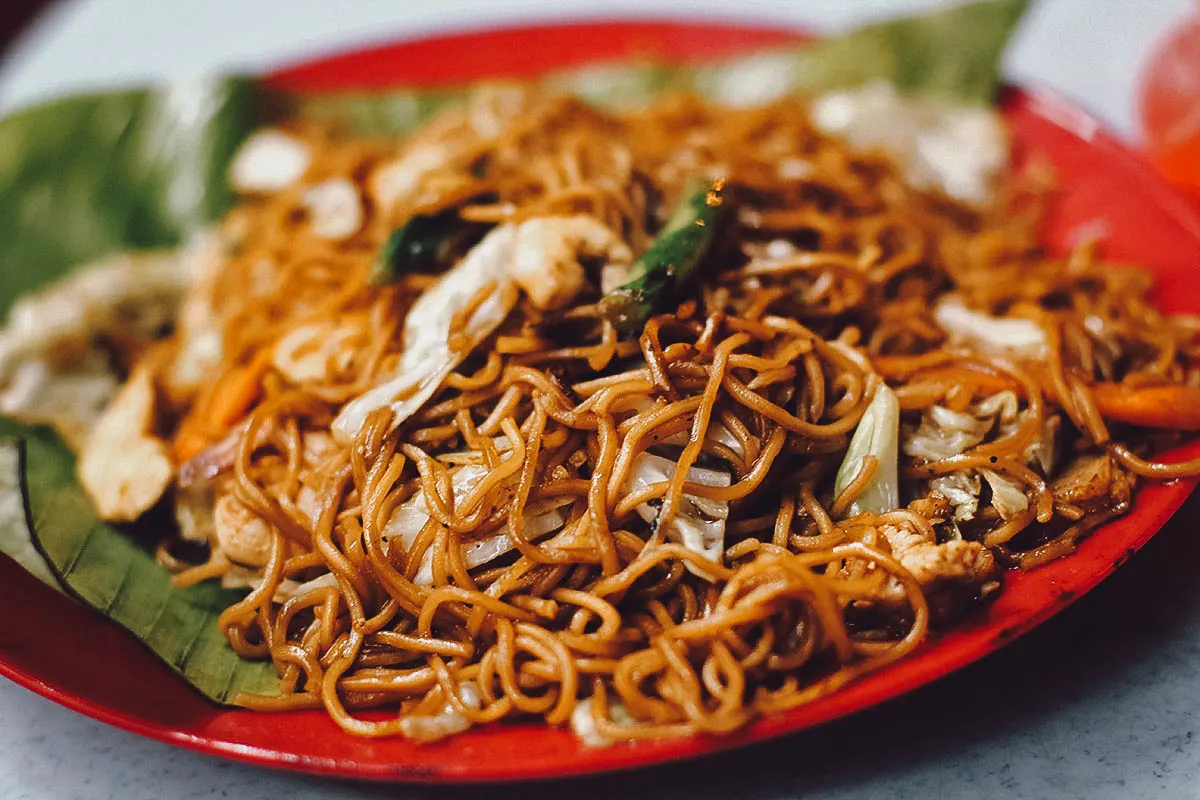
22. Hokkien Mee
As its name suggests, hokkien mee is a Hokkien dish popular in Southeast Asian countries like Malaysia, Singapore, and Indonesia. The term can be confusing because it’s used to describe three distinct versions of the dish.
Singaporean hokkien mee or hae mee refers to a stir-fried dish made with egg noodles and rice noodles garnished with prawns, fish cake, pork ribs, squid, spring onions, and fried pork or chicken lard.
The Kuala Lumpur version of hokkien mee (pictured below), which is also referred to as hokkien char mee, is similar to the Singaporean version except its made with a thick dark soy sauce.
The third and final version of hokkien mee is from Penang. Like Singaporean hokkien mee, it can also be referred to as hae mee. But unlike the Singaporean version, Penang hokkien mee refers to a noodle soup dish made with egg noodles and rice vermicelli in a rich broth flavored with prawn heads and shells, and pork ribs.
If that weren’t confusing enough, there happens to be a Singaporean noodle soup dish called prawn mee that’s very similar to Penang hokkien mee.
RECIPE: Hokkien mee
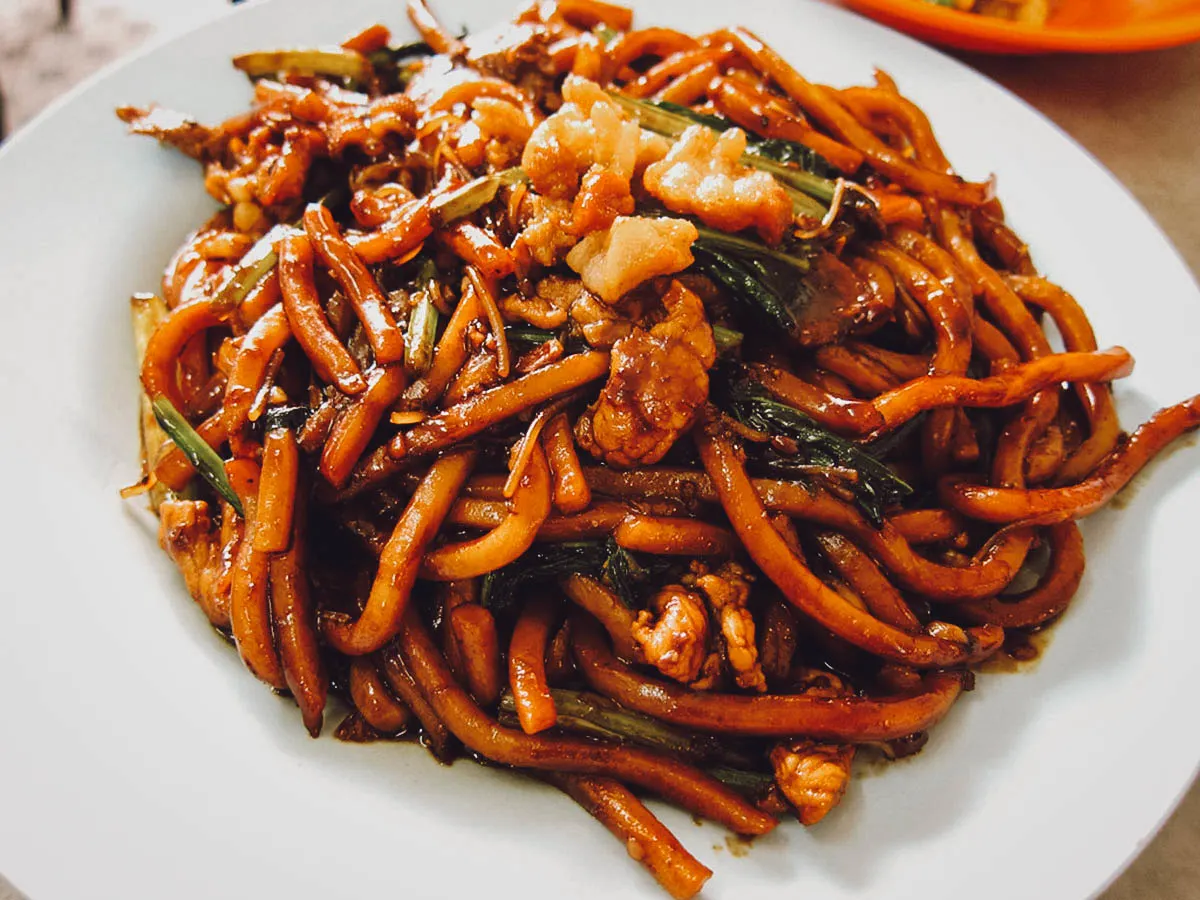
“Hokkien Mee” by Charles Haynes, used under CC BY-SA 2.0 / Processed in Photoshop and Lightroom
23. Mee Rebus
Mee rebus refers to an Indonesian noodle soup dish that’s also popular in Malaysia and Singapore. It’s made with egg noodles cooked in a spicy and slightly sweet curry-like gravy.
Mee rebus gravy is made with a host of ingredients like shrimp or tauchu (preserved fermented yellow soybeans) broth, shallots, lemongrass, galangal, kaffir lime leaf, and corn starch as a thickening agent.
It can be garnished with any number of ingredients like hard-boiled eggs, dried shrimp, boiled potatoes, fried shallots, spring onions, green chilis, and bean sprouts.
RECIPE: Mee rebus
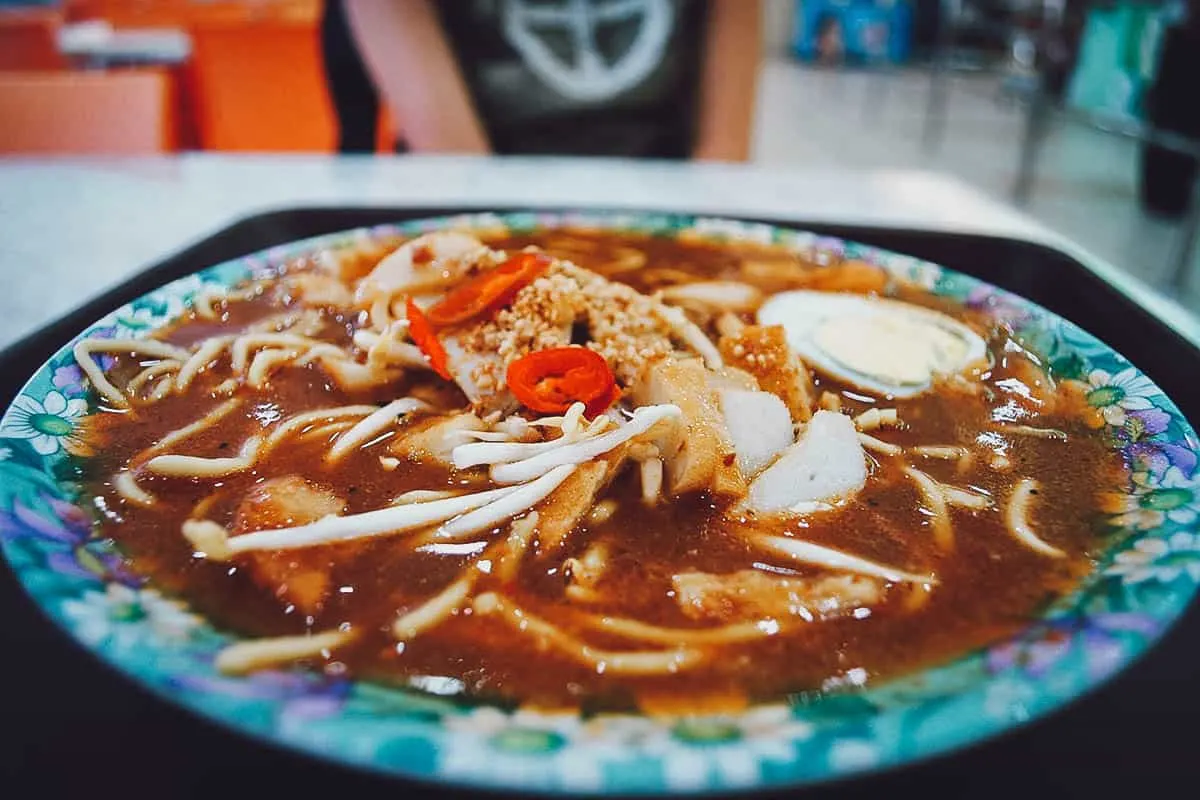
“Mee Rebus – Food Garden, LCCT RM5” by Alpha, used under CC BY-SA 2.0 / Processed in Photoshop and Lightroom
RICE DISHES
In Malaysia, you’ll come across many dishes with the word nasi in their name. Nasi means “rice” so these all refer to Malaysian rice meals made with a variety of different side dishes.
24. Nasi Lemak
When many people think of Malaysian food, the first dish that comes to mind is nasi lemak. It’s a Malaysian national dish and perhaps the one dish that best represents Malaysian cuisine.
Nasi lemak literally means “oily or fatty rice” and refers to a rice meal made with fragrant rice cooked in coconut milk and pandan leaf. It’s served with a side of sambal and garnishes like cucumber slices, ikan bilis (small fried anchovies), roasted peanuts, and a hard-boiled or fried egg. When eaten as a more substantial meal, it’s served with other viands like fried chicken, sambal sotong, rendang, or fried fish.
Nasi lemak is typically eaten for breakfast though it’s often enjoyed throughout the day. It’s commonly sold at hawker centers and roadside stalls and is equally popular in Singapore as it is in Malaysia.
RECIPE: Nasi lemak
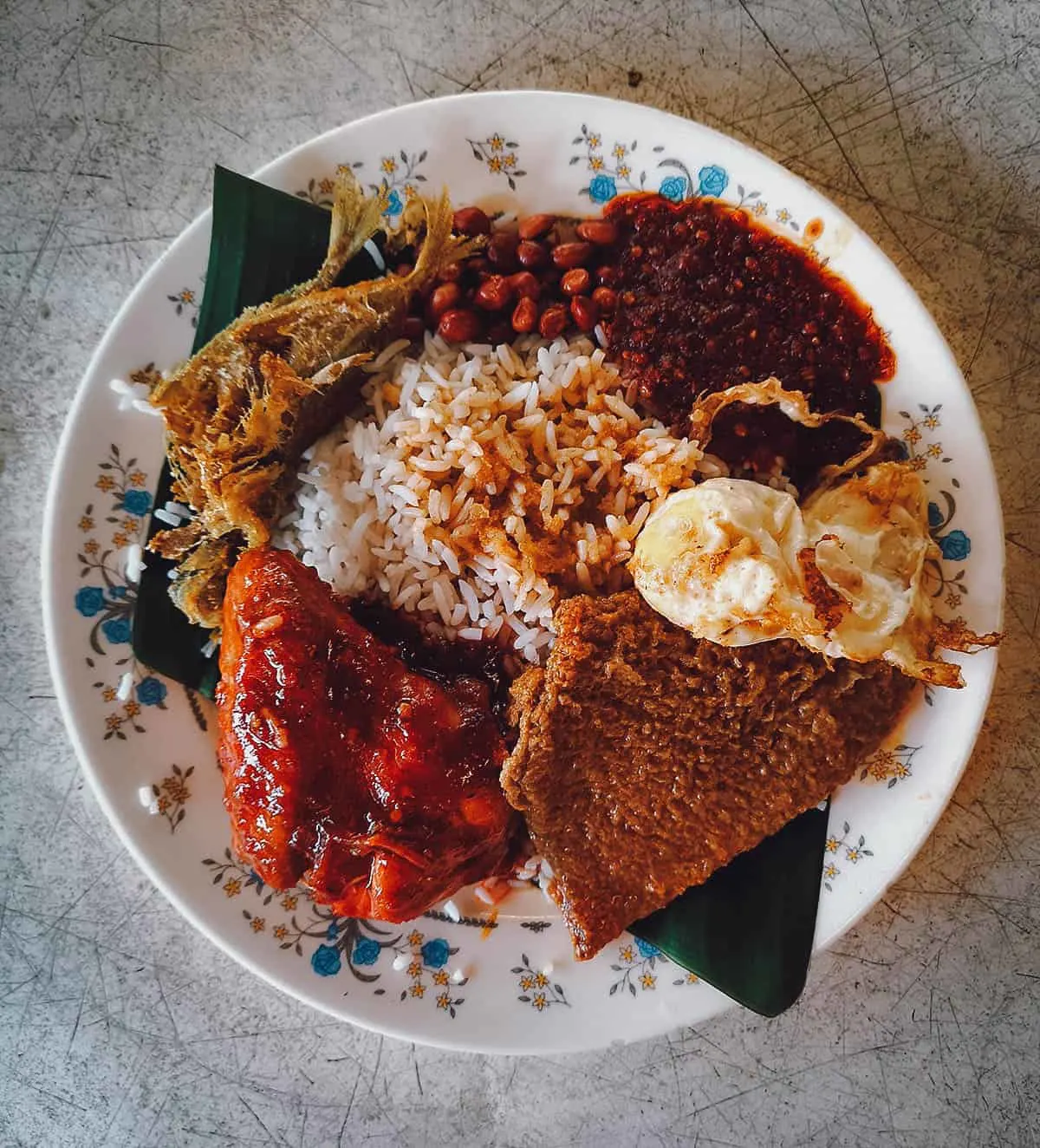
25. Nasi Kandar
Nasi kandar is a type of Malaysian rice meal popular in Penang. It’s a Tamil Muslim dish consisting of plain or mildly flavored steamed rice served with a variety of curries and side dishes.
Proteins served with nasi kandar typically include fried chicken, beef curry, lamb, fish roe, fried prawns, and fried squid. Eggplant, okra, and bitter gourd are the most commonly served vegetables, all of which are served on a single plate with rice flooded with a mixture of curries.
As you can see below, nasi kandar is a beautiful chaotic mess of flavor and texture. It’s a popular Malaysian dish and one of the best things you can have in Penang.
RECIPE: Nasi kandar
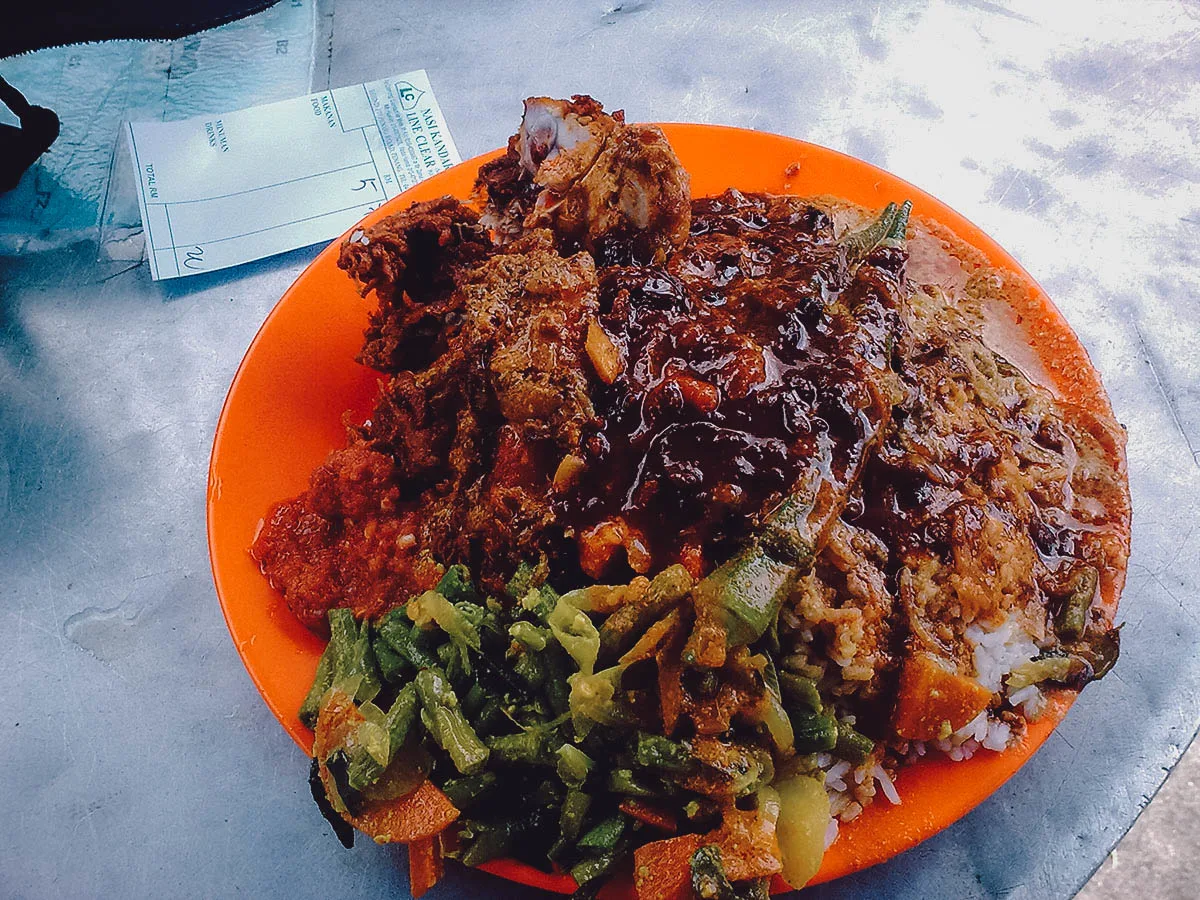
“Nasi Kandar Line Clear” by amrufm, used under CC BY 2.0 / Processed in Photoshop and Lightroom
26. Nasi Kerabu
Nasi kerabu has to be one of the prettiest Malaysian rice dishes. It’s known for its blue rice which gets its color from the petals of the butterfly pea flower.
Nasi kerabu is often topped with salad and served with a side of salted egg, solok lada (stuffed chilis), keropek, dried fish, and fried chicken. It’s said to be a Peranakan dish from the Kelantan state of Malaysia, with the blue rice being a Kelantanese preference.
RECIPE: Nasi kerabu kelantan
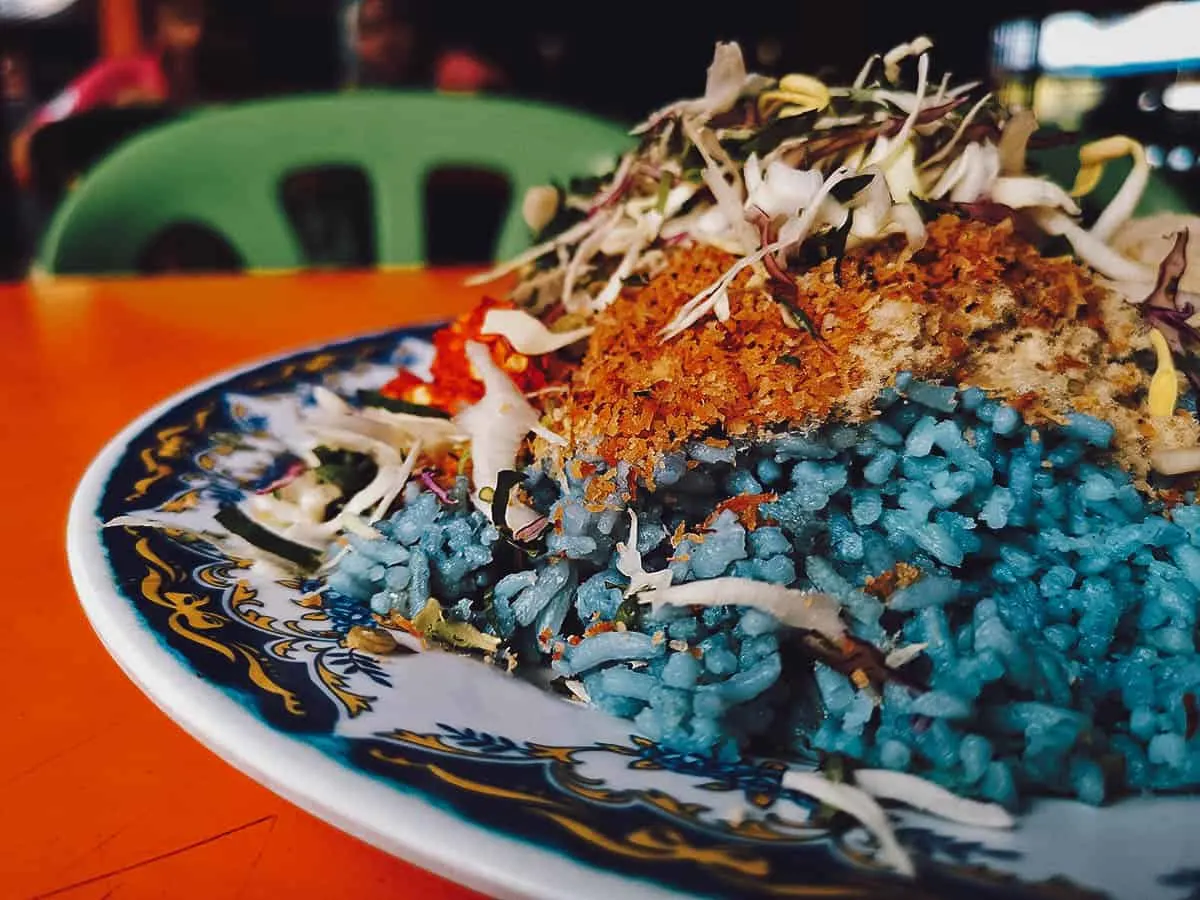
27. Nasi Dagang
Nasi dagang refers to a dish made with rice steamed with thick coconut milk, shallots, lemongrass, and fenugreek seeds. It’s a common Malaysian breakfast food in the eastern coastal states of peninsular Malaysia like Terengganu, Kelantan, and parts of Pahang and eastern Johor.
Nasi dagang is known for its interesting fragrance and unique nutty taste. It’s commonly served with sambal, kari ikan (fish curry), hard-boiled eggs, and pickled vegetables.
RECIPE: Nasi dagang with fish curry
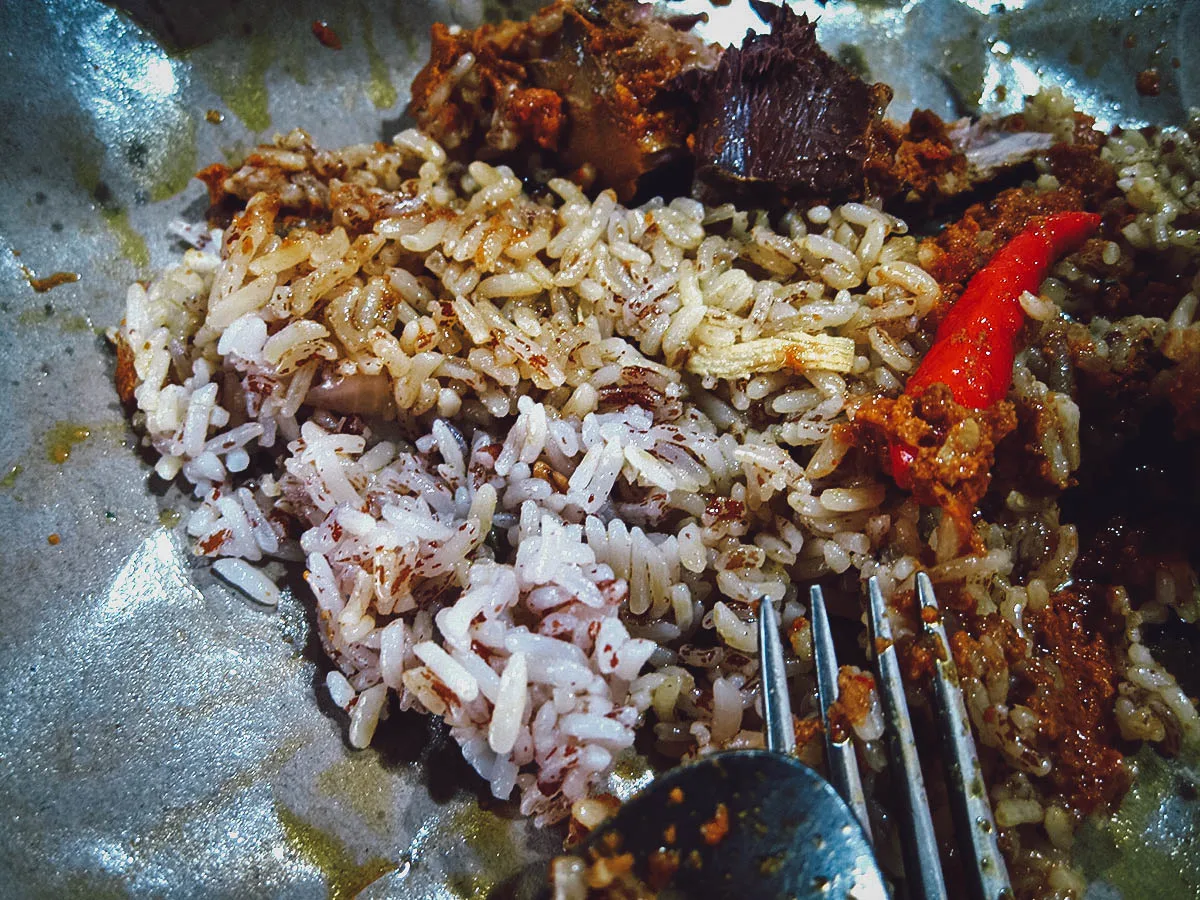
“Nasi dagang” by surtr, used under CC BY-SA 2.0 / Processed in Photoshop and Lightroom
DESSERTS / DRINKS
28. Kuih
Kuih is the blanket term used to describe a large family of bite-sized snacks or dessert foods popular in Malaysia and in other parts of Southeast Asia like Singapore, Brunei, and Indonesia.
Kuih is a broad term that refers to a wide range of Malaysian food products like cakes, cookies, biscuits, dumplings, pudding, and pastries, most of which are made from rice or glutinous rice. They’re often steamed and usually sweet, though savory versions of kuih do exist.
Recipes vary but the most common flavoring ingredients in Malaysian kuih include grated coconut, coconut cream, pandan leaves, and gula melaka. Most have a soft but firm texture thanks to a batter made from a mix of starches like rice flour, glutinous rice flour, tapioca flour, and mung bean flour.
There are dozens of varieties of kuih in all shapes and colors. Many are quite vibrant and colorful, making them a popular and ideal festival food in Malaysia.
RECIPE: Kuih seri muka
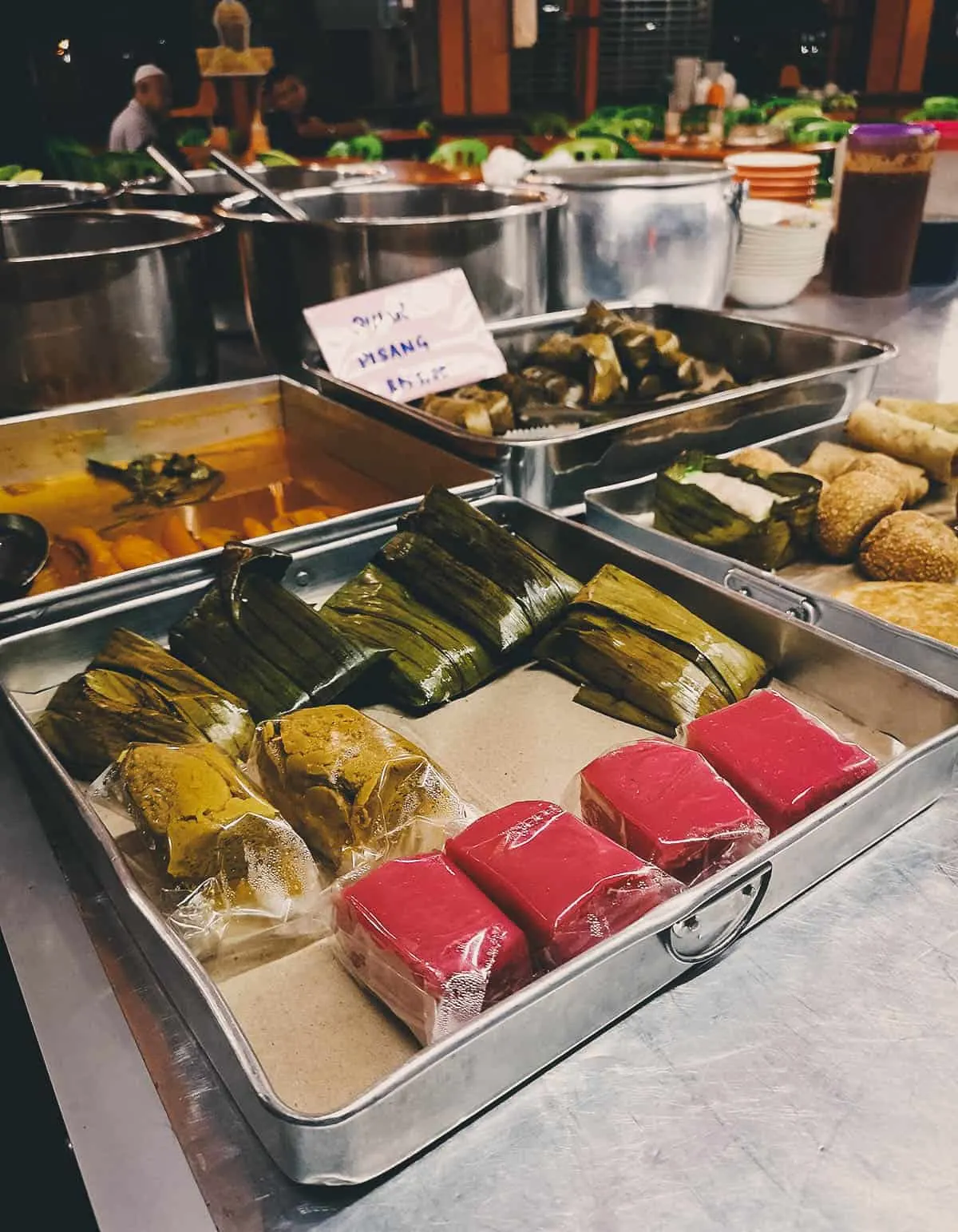
29. Apam Balik
Apam balik refers to a sweet type of murtabak, which is a family of stuffed pancakes or pan-fried breads common in the Arabian Peninsula and Southeast Asia. In Indonesia, apam balik is known as martabak manis or “sweet martabak”.
Apam balik is made from a mixture of flour, eggs, sugar, baking soda, coconut milk, and water. The batter is cooked in a round frying pan and spread with butter or margarine, sugar, and a variety of toppings like crushed peanuts, chocolate sprinkles, and cheese.
Before serving, the apam balik is folded in half and cut into smaller pieces so the fillings go in the middle, making it easier to eat.
RECIPE: Apam balik
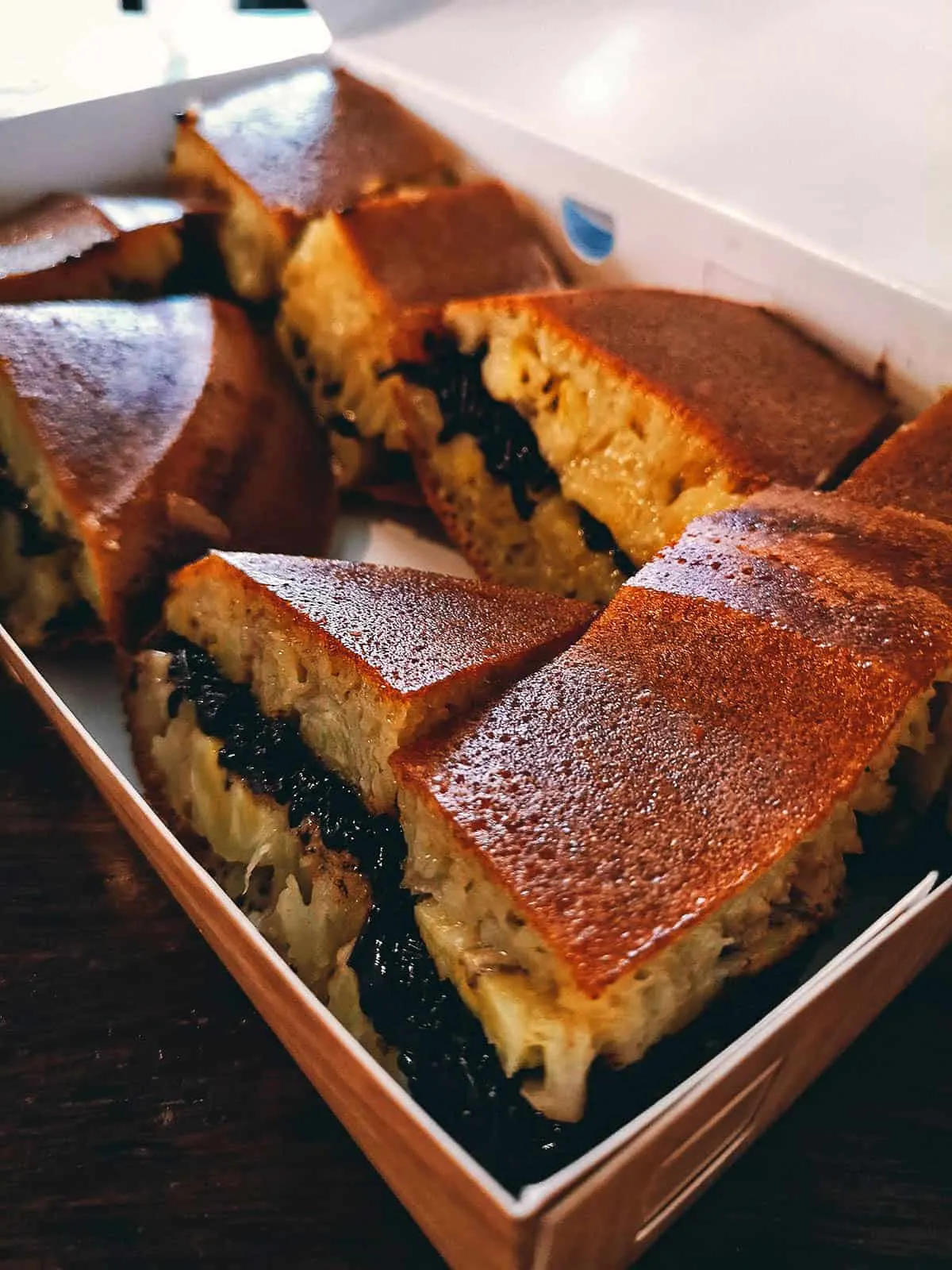
30. Roti Tisu
Roti tisu (or roti tissue or roti helikopter) refers to a type of roti canai. It’s much thinner and crispier than your typical roti canai and served in the shape of a cone. It’s often enjoyed with a sweet dip like kaya jam or even ice cream.
RECIPE: Roti tisu
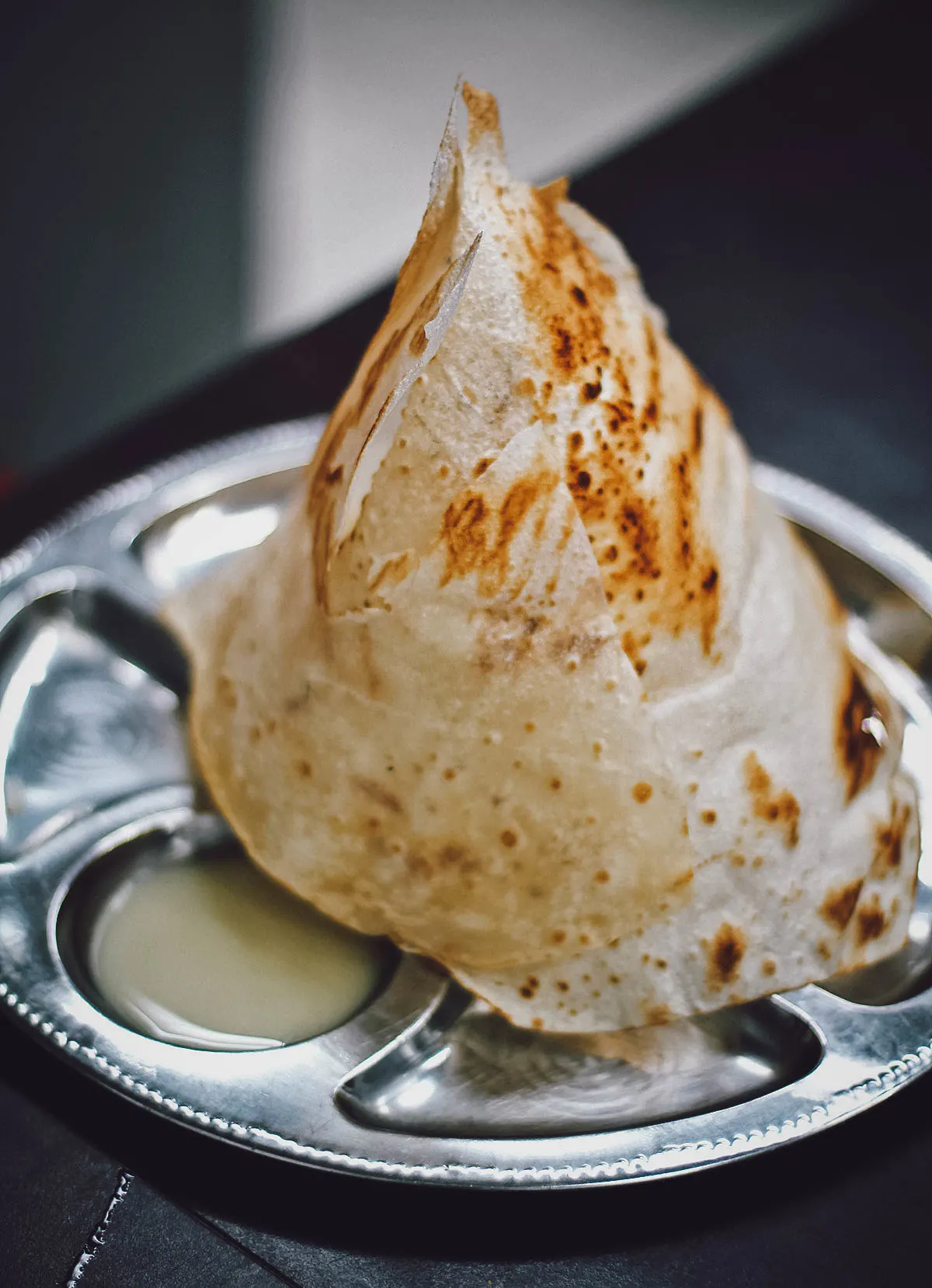
31. Pisang Goreng
Pisang goreng refers to banana fritters popular in Malaysia, Indonesia, Singapore, and Brunei.
To prepare, plantains are dipped in batter and deep-fried. Most Malaysian street food sellers will serve them as is but fancier coffee shops and restaurants may serve them with powdered sugar, cinnamon, cheese, jam, condensed milk, or ice cream.
RECIPE: Pisang goreng
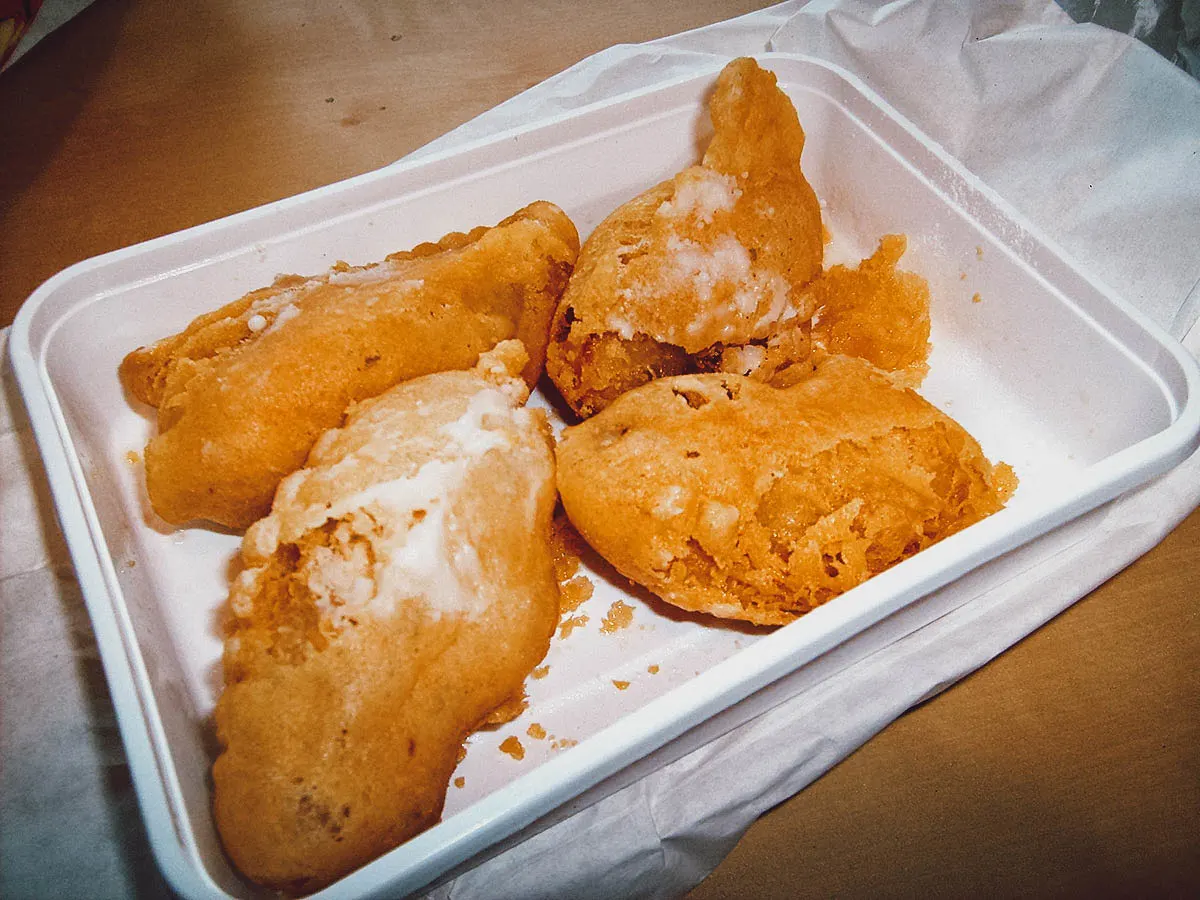
“Pisang Goreng” by tacowitte, used under CC BY 2.0 / Processed in Photoshop and Lightroom
32. Cendol
Cendol refers to an iced dessert popular in many Southeast Asian countries like Malaysia, Indonesia, Singapore, Brunei, Thailand, and Laos. Its made with shaved ice mixed with green rice jelly noodles, coconut milk, sweetened red beans, and gula melaka (palm sugar syrup).
Depending on the vendor, Malaysian cendol can be made with additional ingredients as well like jackfruit, glutinous rice, grass jelly, creamed corn, and my personal favorite – durian.
RECIPE: Cendol
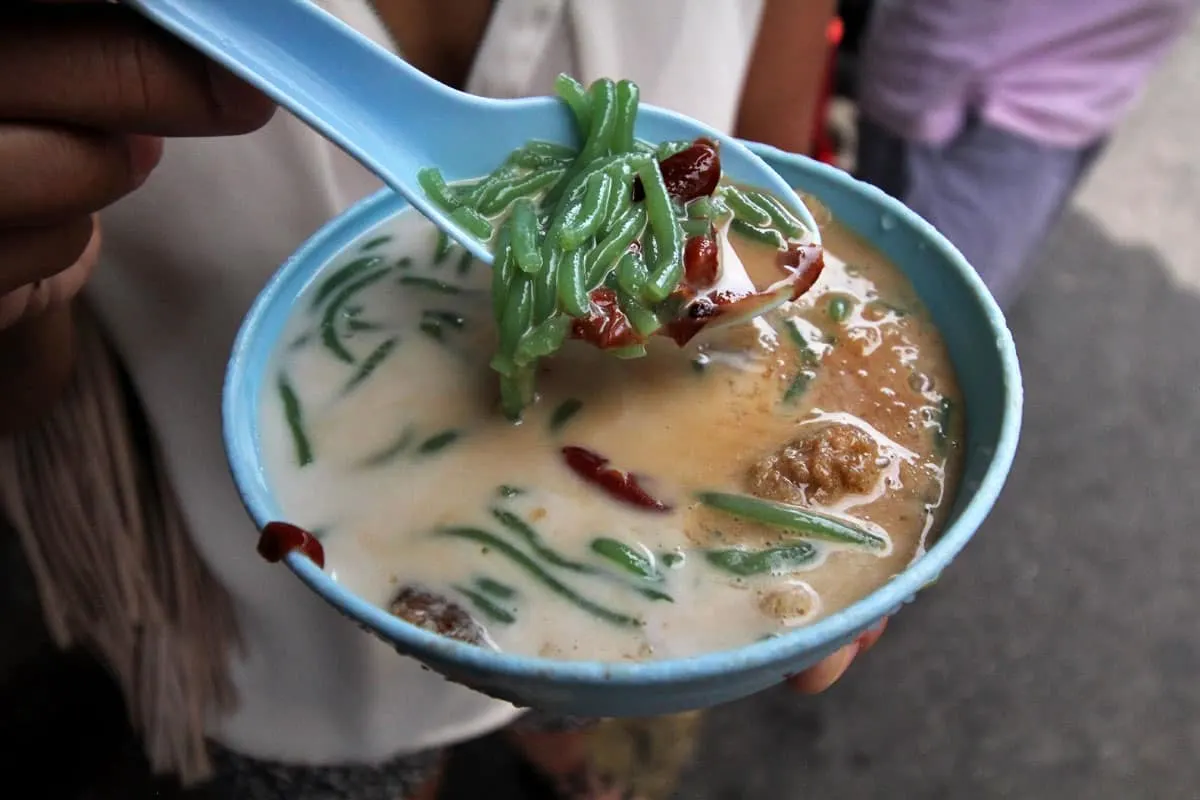
33. Ais Kacang
Ais kacang refers to a Malaysian shaved ice dessert that’s also popular in Singapore and Brunei. Its name literally means “bean ice” because it was originally made using just shaved ice and red beans.
Today, ais kacang is made with a host of different ingredients like grass jelly, sweet corn, attap chee (palm seed), roasted peanuts, nata de coco, and agar agar. The ingredients are layered around a mound of shaved ice before being drizzled with evaporated or condensed milk and one or more types of colored syrup.
Ais kacang is commonly referred to as ABC in Malaysia. ABC stands for air batu campur meaning “mixed ice”.
RECIPE: Ais kacang
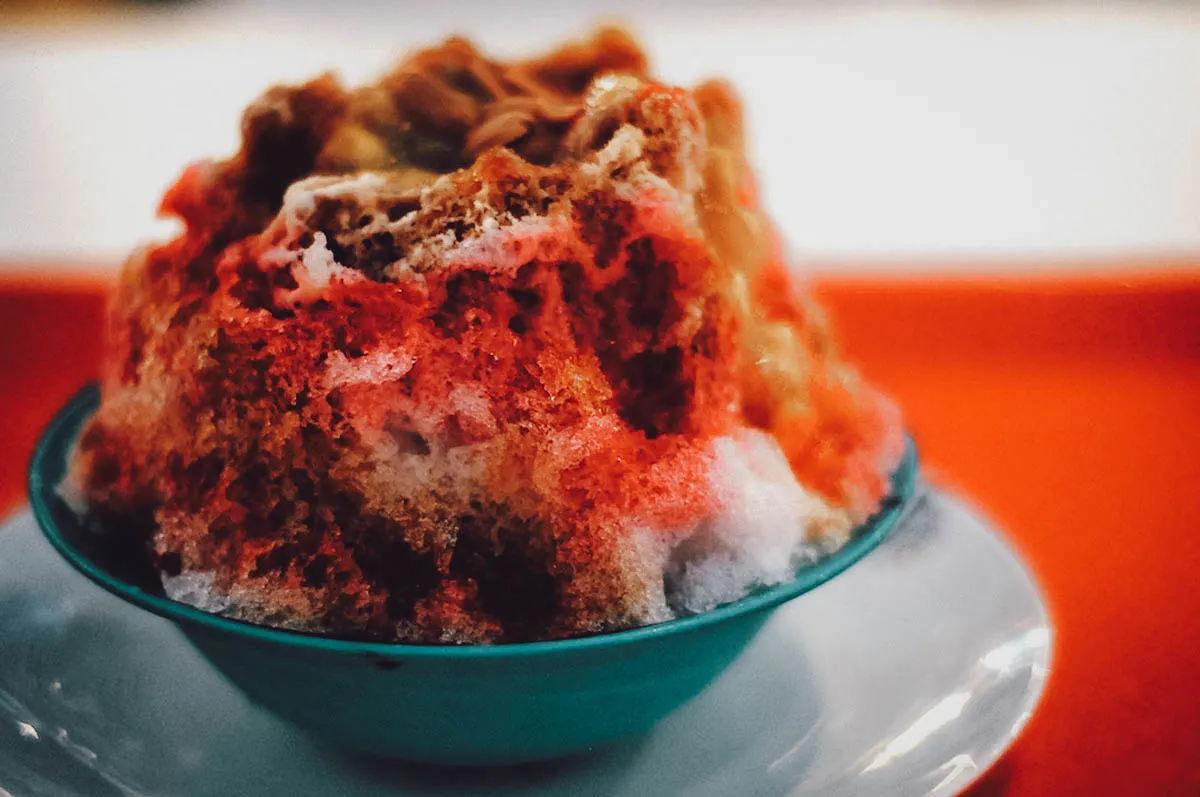
“Ais Kacang” by dilettantiquity, used under CC BY-SA 2.0 / Processed in Photoshop and Lightroom
34. Durian
Durian is one of the most notorious Southeast Asian fruits. It’s notorious for its intensely pungent odor that some say is similar to gym socks or raw sewage. Many people can’t get past the smell which is a shame because for me, durian is one of the most unique and best-tasting fruits in the world.
Aside from its intense odor, durian is known for its thick thorny rind. It belies a soft and creamy flesh that’s been been likened to a rich custard flavored with almonds. It’s absolutely delicious and not something you’d expect from such a pungent-smelling fruit.
Malaysia is the world’s second largest producer of durian, behind only Thailand. It boasts over 130 varieties of the fruit with some of the most prized being Musang King, D24, and Red Prawn.
RECIPE: Durian fritters
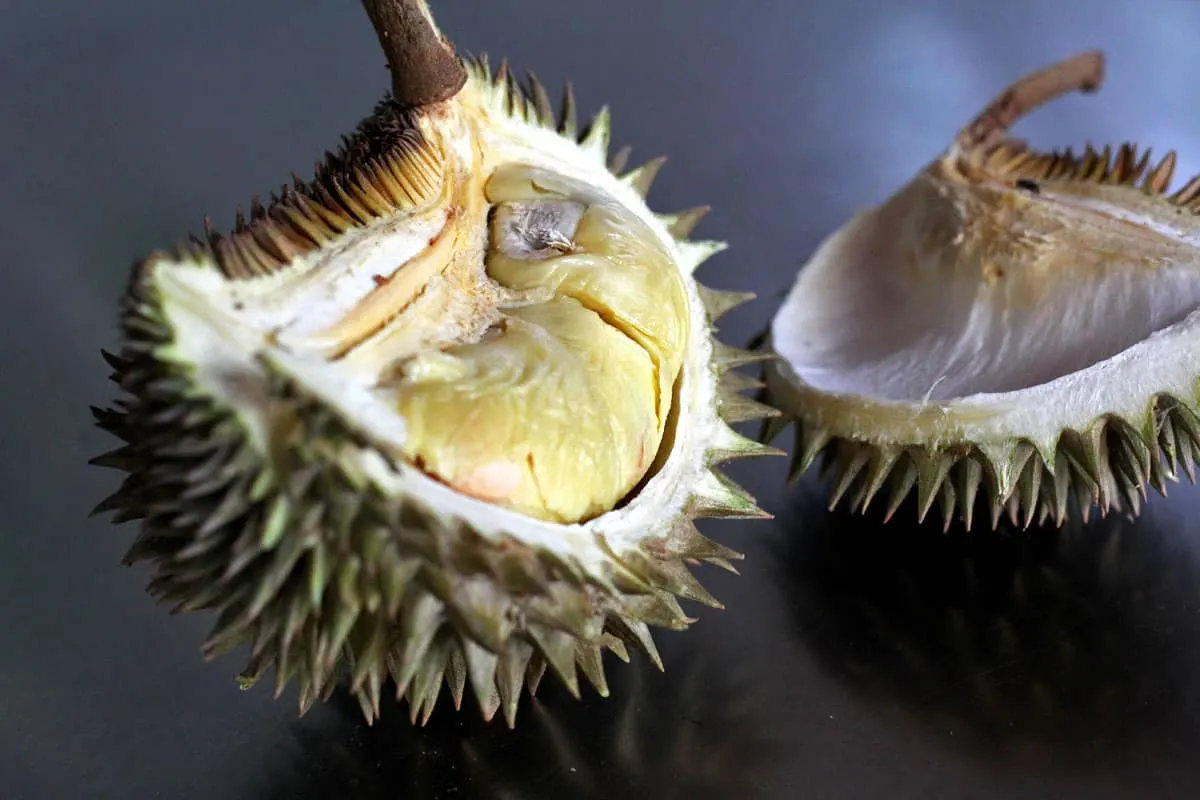
35. Teh Tarik
Teh tarik literally means “pulled tea” and refers to a hot milk tea beverage popular in Malaysia, Singapore, and Indonesia. It gets its name from the way its poured or “pulled” from a distance during preparation.
Teh tarik is made from a strong brew of black tea mixed with condensed milk. To serve, vendors will pour the liquid back and forth from a distance to aerate the drink and improve its flavor.
As you can see below, teh tarik vendors have gotten so good at it that they can pour the drink from a few feet away without spilling a drop.
RECIPE: Teh tarik
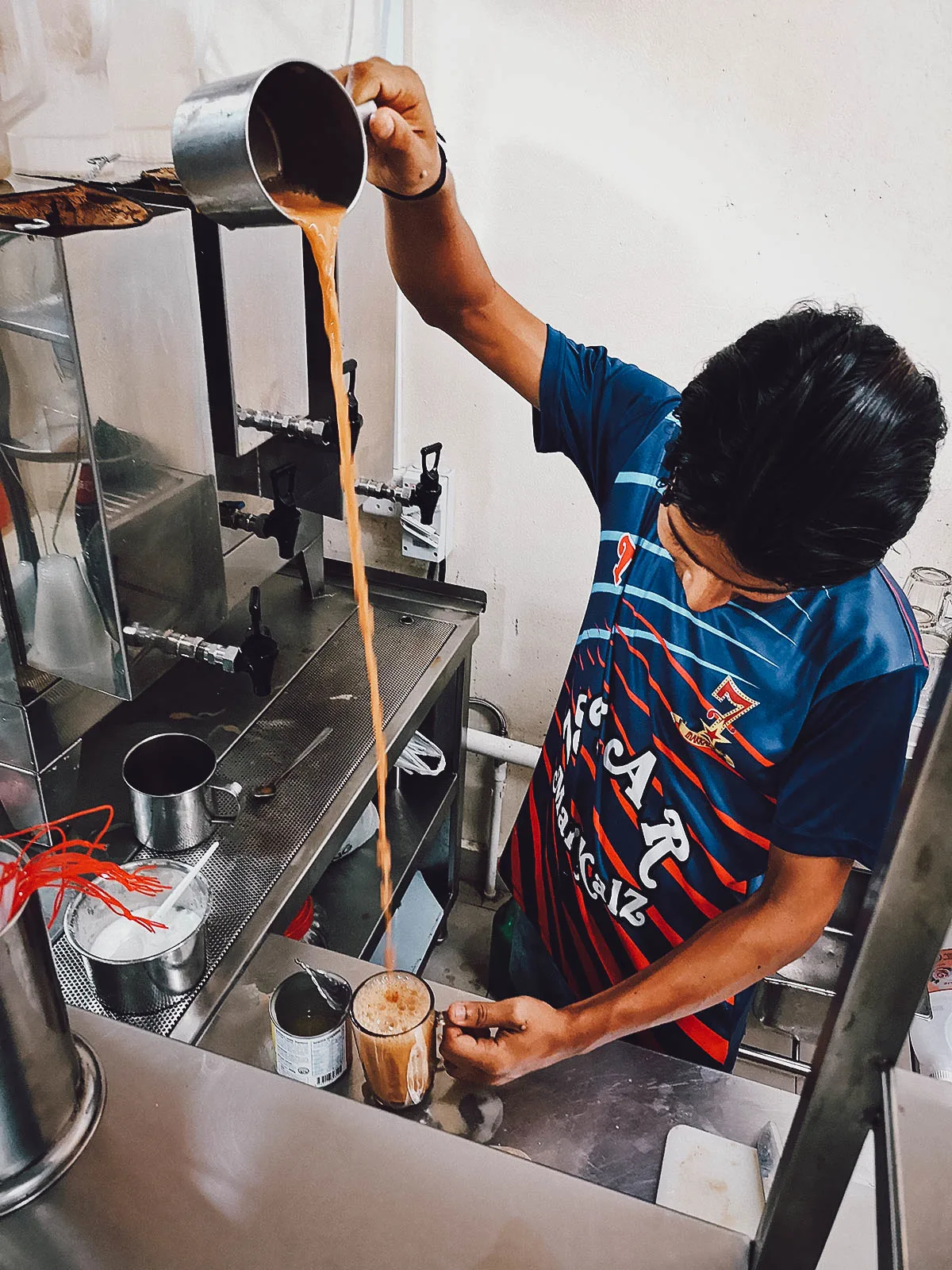
MALAYSIAN FOOD TOURS
No one knows Malaysian food better than a local, so what better way to experience Malaysian cuisine than by going on a food tour? A food-obsessed local will take you to all the best spots and explain each dish to you in more detail. If you’re visiting Malaysia, then check out Get Your Guide for a list of food tours in Kuala Lumpur and in other cities throughout the country.
MALAYSIAN COOKING CLASSES
Aside from food tours, we also enjoy taking cooking classes on trips. In my opinion, it’s one of the best ways to learn about an unfamiliar cuisine. Eating Malaysian food is one thing but learning how to make it is another. If you’re visiting Malaysia, then check out Cookly for a list of cooking classes in different cities throughout the country.
FINAL THOUGHTS ON MALAYSIAN FOOD
I hope you enjoyed reading this Malaysian food guide as much as I enjoyed writing it. Malaysian food has always felt somewhat familiar to me thanks to its many similarities with Filipino food.
True to its ethnic makeup, Malaysian food is as diverse as it is delicious. It’s been shaped by many cultures and influences so if you’re fond of bold flavors and lots of spice in your food, then you’re going to love Malaysian cuisine.
As always, this Malaysian food guide is a work-in-progress and something we’ll continue to build upon after every return visit to Malaysia. We’ve eaten our way through Kuala Lumpur, Penang, and Langkawi and have our sights set on Ipoh and Malacca next.
Until then, thanks for reading and I hope this food guide helps lead you to some amazing meals in Malaysia.
Disclosure
Some of the links in this Malaysian food guide are affiliate links, meaning we’ll earn a small commission if you make a booking at no additional cost to you. We only recommend products and services that we use ourselves and firmly believe in. We really appreciate your support as it helps us make more of these free travel guides. Thank you so much!

